litchralee 2 days ago • 100%
The thing to keep in mind is that there exist things which have "circumstantial value", meaning that the usefulness of something depends on the beholder's circumstances at some point in time. Such an object can actually have multiple valuations, as compared to goods (which have a single, calculable market value) or sentimental objects ("priceless" to their owner).
To use an easy example, consider a sportsball ticket. Presenting it at the ballfield is redeemable for a seat to watch the game at the time and place written on the ticket. And it can be transferred -- despite Ticketmaster's best efforts -- so someone else could enjoy the same. But if the ticket is unused and the game is over, then the ticket is now worthless. Or if the ticket holder doesn't enjoy watching sportsball, their valuation of the ticket is near nil.
So to start, the coupon book is arguable "worth" $30, $0, or somewhere in between. Not everyone will use every coupon in the book. But if using just one coupon will result in a savings of at least $1, then perhaps the holder would see net-value from that deal. In no circumstance is KFC marking down $30 on their books because they issued coupons that somehow total to $30.
That said, I'm of the opinion that if a donation directly results in me receiving something in return... that's not a donation. It's a sale or transaction dressed in the clothes of charity. Plus, KFC sends coupons in the mail for free anyway.
litchralee 5 days ago • 92%
Notwithstanding the possible typo in the title, I think the question is why USA employers would prefer to offer a pension over a 401k, or vice-versa.
For reference, a pension is also known as a defined benefit plan, since an individual has paid into the plan for the minimum amount will be entitled to some known amount of benefit, usually in the form of a fixed stipend for the remainder of their life, and sometimes also health insurance coverage. USA's Social Security system is also sometimes called the public pension, because it does in-fact pay a stipend in old age and requires a certain amount of payments into the fund during one's working years.
Whereas a 401k is uncreatively named after the tax code section which authorized its existence, initially being a deferred compensation mechanism -- aka a way to spread one's income over more time, to reduce the personal taxes owed in a given year -- and then grew into the tax-advantaged defined contribution plan that it is today. That is, it is a vessel for saving money, encouraged by tax advantages and by employer contributions, if any.
The superficial view is that 401k plans overtook pensions because companies wouldn't have to contribute much (or anything at all), shifting retirement costs entirely onto workers. But this is ahistorical since initial 401k plans offered extremely generous employer contribution rates, some approaching 15% matching. Of course, the reasoning then was that the tax savings for the company would exceed that, and so it was a way to increase compensation for top talent. In the 80s and 90s was when the 401k was only just taking hold as a fringe benefit, so you had to have a fairly cushy job to have access to a 401k plan.
Another popular viewpoint is that workers prefer 401k plans because it's more easily inspectable than a massive pension fund, and history has shown how pension funds can be mismanaged into non-existence. This is somewhat true, if US States' teacher pension funds are any indication, although Ontario Teacher's Pension Plan would be the counterpoint. Also, the 401k plan participants at Enron would have something to complain about, as most of the workers funds were invested in the company itself, delivering a double whammy: no job, and no retirement fund.
So to answer the question directly, it is my opinion that the explosion of 401k plans and participants in such plans -- to the point that some US states are enacting automatic 401k plans for workers whose employers don't offer one -- is due to 1) momentum, since more and more employers keep offering them, 2) but more importantly, because brokers and exchanges love managing them.
This is the crux: only employers can legally operate a 401k plan for their employees to participate in. But unless the employer is already a stock trading platform, they are usually ill-equiped to set up an integrated platform that allows workers to choose from a menu of investments which meet the guidelines from the US DOL, plus all other manner of regulatory requirements. Instead, even the largest employers will partner with a financial services company who has expertise on offering a 401k plan, such as Vanguard, Fidelity, Merrill Edge, etc.
Naturally, they'll take a cut on every trade or somehow get compensated, but because of the volume of 401k investments -- most people auto-invest every paycheck -- even small percentages add up quickly. And so, just like the explosion of retail investment where ordinary people could try their hand at day-trading, it's no surprise that brokerages would want to extend their hand to the high volume business of operating 401k plans.
Whereas, how would they make money off a pension fund? Pension funds are multi-billion dollar funds, so they can afford their own brokers to directly buy a whole company in one-shot, with no repeat business.
litchralee 1 week ago • 100%
Almost. By virtue of being a smaller antenna, the 30 cm panel does not focus its energy as tightly as a larger (eg 60 cm) antenna. Likewise, a smaller antenna does not pick up (ie receive) as much energy as a larger antenna does. Thus, by using a 30 cm panel, less of the high energy from the opposite radio will reach the receiver, and that keeps the receiver from being damaged.
In RF engineering, there is a careful balance between output power, antenna size/shape, environmental conditions, and desired link quality. Whoever built the radio link originally did not apparently perform the necessary calculation. I'm not an RF engineer, but for spanning a mere 50 meters, this 20 cm antenna with built-in radio should be more than sufficient for a basic link.
litchralee 1 week ago • 100%
Normally, increased RF power is helpful to overcome interference or noise. Just like how normally, an automobile or airplane will be easier to operate if it has a bigger engine with more power.
At some point, though, the extra RF or engine power is no longer beneficial but also isn't harmful. And if you go significantly beyond that, then you end up in a region where the extra power is downright harmful and is actively working against you.
Consider an automobile driving in a rainstorm. Having more power is bad, because the tires can lose grip more easily, leading to a crash. In an airplane that has gotten into a stall, applying power is the wrong solution and just aggravates the stall, which is not good.
Here, adding more RF power is just cooking the other receiver like it's a Thanksgiving turkey. The extra power is no longer helpful for making communications, and may be physically damaging the receiver.
litchralee 1 week ago • 100%
Although copyright and patents (and trademarks) are lumped together as "intellectual property", there's almost nothing which is broadly applicable to them all, and they might as well be considered separately. The only things I can think of -- and I'm not a lawyer of any kind -- are that: 1) IP protection is mentioned vaguely in the US Constitution, and 2) they all behave as property, in that they can be traded/reassigned. That's it.
With that out of the way, it's important to keep in mind that patent rights are probably the strongest in the family of IP, since there's no equivalent "fair use" (US) or "fair dealing" (UK) allowance that copyright has. A patent is almost like owning an idea, whereas copyright is akin to owning a certain rendition plus a derivative right.
Disney has leaned on copyright to carve for themselves an exclusive market of Disney characters, while also occasionally renewing their older characters (aka derivatives), so that's why they lobby for longer copyright terms.
Whereas there isn't really a singular behemoth company whose bread-and-butter business is to churn out patents. Inventing stuff is hard, and so the lack of such a major player means a lack of lobbying to extend patent terms.
To be clear, there are companies who rely almost entirely on patent law for their existence, just like Disney relies on copyright law. But type foundries (companies that make fonts) are just plainly different than Disney. Typefaces (aka fonts) as a design can be granted patents, and then the font files can be granted copyright. But this is a special case, I think.
The point is: no one's really clamoring for longer parents, and most people would regard a longer exclusive term on "ideas" to be very problematic. Esp if it meant pharmaceutical companies could engage in even more price-gouging, for example.
litchralee 1 week ago • 100%
The original tech installed a 60cm panel for a rf link which is no more than 50M.
In case anyone else has this minor confusion, this is a radio link between two buildings which are 50 meters apart. And a square, directional flat-panel antenna that is 60 centimeters on a side is grossly overkill for the short distance involved.
litchralee 1 week ago • 100%
To be clear, the legs would support the topper when it's positioned over the tub, and also support the topper when it's beside the tub? If that's the case, do the legs really need to fold away? Would fixed legs be acceptable? Or is there a requirement that the legs be foldable to provide clearance over the edge of the tub?
litchralee 1 week ago • 100%
If you hold a patent, then you have an exclusive right to that invention for a fixed period, which would be 20 years from the filing date in the USA. That would mean Ford could not claim the same or a derivative invention, at least not for the parts which overlap with your patent. So yes, you could sit on your patent and do nothing until it expires, with some caveats.
But as a practical matter, the necessary background research, the application itself, and the defense of a patent just to sit on it would be very expensive, with no apparent revenue stream to pay for it. I haven't looked up what sort of patent Ford obtained (or maybe they've merely started the application) but patents are very long and technical, requiring whole teams of lawyers to draft properly.
For their patent to be valid, they must not overlap with an existing claim, as well as being novel and non-obvious, among other requirements. They would only file a patent to: 1) protect themselves from competition in future, 2) expect that this patent can be monetized by directly implementing it, or licensing it out to others, or becoming a patent troll and extracting nuisance-value settlements, or 3) because they're already so deep in the Intellectual Property land-grab that they must continue to participate by obtaining outlandish patents. The latter is a form of "publish or perish" and allows them to appear like they're on the cutting edge of innovation.
A patent can become invalidated if it is not sufficiently defended. This means that if no one even attempts to infringe, then your patent would be fine. But if someone does, then you must file suit or negotiate a license with them, or else they can challenge the validity of your patent. If they win, you'll lose your exclusive rights and they can implement the invention after all. This is not cheap, and Ford has deep pockets.
 photo.walgreens.com
photo.walgreens.com
Use the code on the Walgreens app and the website to claim the same offer twice! When uploading photos using the desktop website, make sure to select Full Resolution in the Upload Preferences.
litchralee 2 weeks ago • 100%
I'll address your question in two parts: 1) is it redundant to store both the IP subnet and its subnet mask, and 2) why doesn't the router store only the bits necessary to make the routing decision.
Prior to the introduction of CIDR -- which came with the "slash" notation, like /8 for the 10.0.0.0 RFC1918 private IPv4 subnet range -- subnets would genuinely be any bit arrangement imaginable. The most sensible would be to have contiguous MSBit-justified subnet masks, such as 255.0.0.0. But the standard did not preclude using something unconventional like 255.0.0.1.
For those confused what a 255.0.0.1 subnet mask would do -- and to be clear, a lot of software might prove unable to handle this -- this is describing a subnet with 2^23 addresses, where the LSBit must match the IP subnet. So if your IP subnet was 10.0.0.0, then only even numbered addresses are part of that subnet. And if the IP subnet is 10.0.0.1, then that only covers odd numbered addresses.
Yes, that means two machines with addresses 10.69.3.3 and 10.69.3.4 aren't on the same subnet. This would not be allowed when using CIDR, as contiguous set bits are required with CIDR.
So in answer to the first question, CIDR imposed a stricter (and sensible) limit on valid IP subnet/mask combinations, so if CIDR cannot be assumed, then it would be required to store both of the IP subnet and the subnet mask, since mask bits might not be contiguous.
For all modern hardware in the last 15-20 years, CIDR subnets are basically assumed. So this is really a non-issue.
For the second question, the router does in-fact store only the necessary bits to match the routing table entry, at least for hardware appliances. Routers use what's known as a TCAM memory for routing tables, where the bitwise AND operation can be performed, but with a twist.
Suppose we're storing a route for 10.0.42.0/24. The subnet size indicates that the first 24 bits must match a prospective destination IP address. And the remaining 8 bits don't matter. TCAMs can store 1's and 0's, but also X's (aka "don't cares") which means those bits don't have to match. So in this case, the TCAM entry will mirror the route's first 24 bits, then populate the rest with X's. And this will precisely match the intended route.
As a practical matter then, the TCAM must still be as wide as the longest possible route, which is 32 bits for IPv4 and 128 bits for IPv6. Yes, I suppose some savings could be made if a CIDR-only TCAM could conserve the X bits, but this makes little difference in practice and it's generally easier to design the TCAM for max width anyway, even though non-CIDR isn't supported on most routing hardware anymore.
litchralee 2 weeks ago • 100%
To start off, I'm sorry to hear that you're not receiving the healthcare you need. I recognize that these words on a screen aren't going to solve any concrete problems, but in the interest of a fuller comprehension of the USA healthcare system, I will try to offer an answer/opinion to your question that goes into further depth than simply "capitalism" or "money and profit" or "greed".
What are my qualifications? Absolutely none, whatsoever. Although I did previously write a well-received answer in this community about the USA health insurance system, which may provide some background for what follows.
In short, the USA healthcare system is a hodge-podge of disparate insurers and government entities (collectively "payers"), and doctors, hospitals, clinics, ambulances, and more government entities (collectively "providers"), overseen by separate authorities in each of the 50 US States, territories, tribes, and certain federal departments (collectively "regulators"). There is virtually no national-scale vertical integration in any sense, meaning that no single or large entity has the viewpoint necessary to thoroughly review the systemic issues in this "system", nor is there the visionary leadership from within the system to even begin addressing its problems.
It is my opinion that by bolting-on short-term solutions without a solid long-term basis, the nation was slowly led to the present dysfunction, akin to boiling a frog. And this need not be through malice or incompetence, since it can be shown that even the most well-intentioned entities in this sordid and intricate pantomime cannot overcome the pressures which this system creates. Even when there are apparent winners like filthy-rich plastic surgeons or research hospitals brimming with talented expert doctors of their specialty, know that the toll they paid was heavy and worse than it had to be.
That's not to say you should have pity on all such players in this machine. Rather, I wish to point to what I'll call "procedural ossification", as my field of computer science has a term known as "protocol ossification" that originally borrowed the term from orthopedia, or the study of bone deformities. How very fitting for this discussion.
I define procedural ossification as the loss of flexibility in some existing process, such that rather than performing the process in pursuit of a larger goal, the process itself becomes the goal, a mindless, rote machine where the crank is turned and the results come out, even though this wasn't what was idealized. To some, this will harken to bureaucracy in government, where pushing papers and forms may seem more important that actually solving real, pressing issues.
I posit to you that the USA healthcare system suffers from procedural ossification, as many/most of the players have no choice but to participate as cogs in the machine, and that we've now entirely missed the intended goal of providing for the health of people. To be an altruistic player is to be penalized by the crushing weight of practicalities.
What do I base this on? If we look at a simple doctor's office, maybe somewhere in middle America, we might find the staff composed of a lead doctor -- it's her private practice, after all -- some Registered Nurses, administrative staff, a technician, and an office manager. Each of these people have particular tasks to make just this single doctor's office work. Whether it's supervising the medical operations (the doctor) or operating/maintaining the X-ray machine (technician) or cutting the checks to pay the building rent (office manager), you do need all these roles to make a functioning, small doctor's office.
How is this organization funded? In my prior comment about USA health insurance, there was a slide which showed the convoluted money flows from payers to providers, which I've included below. What's missing from this picture is how even with huge injections of money, bad process will lead to bad outcomes.
In an ideal doctor's office, every patient that walks in would be treated so that their health issues are managed properly, whether that's fully curing the condition or controlling it to not get any worse. Payment would be conditioned upon the treatment being successful and within standard variances for the cost of such treatment, such as covering all tests to rule out contributing factors, repeat visits to reassess the patient's condition, and outside collaboration with other doctors to devise a thorough plan.
That's the ideal, and what we have in the USA is an ossified version of that, horribly contorted and in need of help. Everything done in a doctor's office is tracked with a "CPT/HCPCS code", which identifies the type of service rendered. That, in and of itself, could be compatible with the ideal doctor's office, but the reality is that the codes control payment as hard rules, not considering "reasonable variances" that may have arisen. When you have whole professions dedicated to properly "coding" procedures so an insurer or Medicare will pay reimbursement, that's when we've entirely lost the point and grossly departed from the ideal. The payment tail wags the doctor dog.
To be clear, the coding system is well intentioned. It's just that its use has been institutionalized into only ever paying out if and only if a specific service was rendered, with zero consideration for whether this actually advanced the patient's treatment. The coding system provides a wealth of directly-comparable statistical data, if we wanted to use that data to help reform the system. But that hasn't substantially happened, and when you have fee-for-service (FFS) as the base assumption, of course patient care drops down the priority list. Truly, the acronym is very fitting.
Even if the lead doctor at this hypothetical office wanted to place patient health at the absolute forefront of her practice, she will be without the necessary tools to properly diagnose and treat the patient, if she cannot immediately or later obtain reimbursement for the necessary services rendered. She and her practice would have to absorb costs that a "conforming" doctor's office would have, and that puts her at a further disadvantage. She may even run out of money and have to close.
The only major profession that I'm immediately aware of which undertakes unknown costs with regularity, in the hopes of a later full-and-worthwhile reimbursement, is the legal profession. There, it is the norm for personal injury lawyers to take cases on contingency, meaning that the lawyer will eat all the costs if the lawsuit does not ultimately prevail. But if the lawyer succeeds, then they earn a fixed percentage of the settlement or court judgement, typically 15-22%, to compensate for the risk of taking the case on contingency.
What's particularly notable is that lawyers must have a good eye to only accept cases they can reasonably win, and to decline cases which are marginal or unlikely to cover costs. This heuristic takes time to hone, but a lawyer could start by being conservative with cases accepted. The reason I mention this is because a doctor-patient relationship is not at all as transactional as a lawyer-client relationship. A doctor should not drop a patient because their health issues won't allow the doctor to recoup costs.
The notion that an altruistic doctor's office can exist sustainably under the FFS model would require said doctor to discard the final shred of decency that we still have in this dysfunctional system. This is wrong in a laissez-faire viewpoint, is wrong in a moral viewpoint, and is wrong in a healthcare viewpoint. Everything about this is wrong.
But the most insidious problems are those that perpetuate themselves. And because of all those aforementioned payers, providers, and regulators are merely existing and cannot themselves take the initiative to unwind this mess, it's going to take more than a nudge from outside to make actual changes.
As I concluded my prior answer on USA health insurance, I noted that Congressional or state-level legislation would be necessary to deal with spiraling costs for healthcare. I believe the same would be required to refocus the nation's healthcare procedures to put patient care back as the primary objective. This could come in the form of a single-payer model. Or by eschewing insurance pools outright by extending a government obligation to the health of the citizenry, commonly in the form of a universal healthcare system. Costs of the system would become a budgetary line-item so that the health department can focus its energy on care.
To be clear, the costs still have to be borne, but rather than fighting for reimbursement, it could be made into a form of mandatory spending, meaning that they are already authorized to be paid from the Treasury on an ongoing basis. For reference, the federal Medicare health insurance system (for people over 65) is already a mandatory spending obligation. So upgrading Medicare to universal old-people healthcare is not that far of a stretch,
litchralee 2 weeks ago • 100%
Good luck with your endeavors! Always keep in mind that when debugging a complex problem, try isolating individual components and testing them individually. This can be as easy as swapping a web application with the Python SimpleHTTPServer to validate firewall and reverse proxy configuration.
litchralee 2 weeks ago • 100%
Thank you for that detailed description. I see two things which are of concern: the first is the IPv6 network unreachable. The second is the lost IPv4 connection, as opposed to a rejection.
So staring in order, the machine on the external network that you're running curl on, does it have a working IPv6 stack? As in, if you opened a web browser to https://test-ipv6.com/ , does it pass all or most tests? An immediate "network is unreachable" suggests that external machine doesn't have IPv6 connectivity, which doesn't help debug what's going on with the services.
Also, you said that all services that aren't on port 80 or 443 are working when viewed externally, but do you know if that was with IPv4 or IPv6? I use a browser extension called IPvFoo to display which protocol the page has loaded with, available for Chrome and Firefox. I would check that your services are working over IPv6 equally well as IPv4.
Now for the second issue. Since you said all services except those on port 80, 443 are reachable externally, that would mean the IP address -- v4 or v6, whichever one worked -- is reachable but specifically ports 80 and 443 did not.
On a local network, the norm (for properly administered networks) is for OS firewalls to REJECT unwanted traffic -- I'm using all-caps simply because that's what I learned from Linux IP tables. A REJECT means that the packet was discarded by the firewall, and then an ICMP notification is sent back to the original sender, indicating that the firewall didn't want it and the sender can stop waiting for a reply.
For WANs, though, the norm is for an external-facing firewall to DROP unwanted traffic. The distinction is that DROPping is silent, whereas REJECT sends the notification. For port forwarding to work, both the firewall on your router and the firewall on your server must permit ports 80 and 443 through. It is a very rare network that blocks outbound ICMP messages from a LAN device to the Internet.
With all that said, I'm led to believe that your router's firewall is not honoring your port-forward setting. Because if it did and your server's firewall discarded the packet, it probably would have been a REJECT, not a silent drop. But curl showed your connection timed out, which usually means no notifications was received.
This is merely circumstantial, since there are some OS's that will DROP even on the LAN, based on misguided and improper threat modeling. But you will want to focus on the router's firewall, as one thing routers often do is intercept ports 80 and 443 for the router's own web UI. Thus, you have to make sure there aren't such hidden rules that preempt the port-forwarding table.
litchralee 2 weeks ago • 100%
I'm still trying to understand exactly what you do have working. You have other services exposed by port numbers, and they're accessible in the form <user>.ducksns.org:<port> with no problems there. And then you have Jellyfin, which you're able to access at home using https://jellyfin.<user>.duckdns.org without problems.
But the moment you try accessing that same URL from an external network, it doesn't work. Even if you use HTTP with no S, it still doesn't connect. Do I understand that correctly?
litchralee 2 weeks ago • 100%
I know this is c/programmerhumor but I'll take a stab at the question. If I may broaden the question to include collectively the set of software engineers, programmers, and (from a mainframe era) operators -- but will still use "programmers" for brevity -- then we can find examples of all sorts of other roles being taken over by computers or subsumed as part of a different worker's job description. So it shouldn't really be surprising that the job of programmer would also be partially offloaded.
The classic example of computer-induced obsolescence is the job of typist, where a large organization would employ staff to operate typewriters to convert hand-written memos into typed documents. Helped by the availability of word processors -- no, not the software but a standalone appliance -- and then the personal computer, the expectation moved to where knowledge workers have to type their own documents.
If we look to some of the earliest analog computers, built to compute differential equations such as for weather and flow analysis, a small team of people would be needed to operate and interpret the results for the research staff. But nowadays, researchers are expected to crunch their own numbers, possibly aided by a statistics or data analyst expert, but they're still working in R or Python, as opposed to a dedicated person or team that sets up the analysis program.
In that sense, the job of setting up tasks to run on a computer -- that is, the old definition of "programming" the machine -- has moved to the users. But alleviating the burden on programmers isn't always going to be viewed as obsolescence. Otherwise, we'd say that tab-complete is making human-typing obsolete lol
litchralee 2 weeks ago • 100%
it works fine (but no https)
This would suggest port 443 is not being exposed externally. You might try using a CLI tool like "curl" which is fairly verbose about how it is connecting to a given URL, as part of trying to download the link. If given an HTTPS URL that doesn't work, the output should help point at the issue.
litchralee 2 weeks ago • 100%
Another wonderful post to read, but once again, I'm in shock as to what the Australian frequency regulator seemingly doesn't do. Perhaps it's a tad unfair to compare ACMA to the American FCC -- the latter well-recognized throughout the world for their (often counterfeited) certification mark -- but it seems like ACMA is dropping the ball.
Ubiquiti is probably the top producer outside of China for point-to-point WiFi-based equipment, so I have to imagine that other similar Western national frequency regulators to the FCC have the same demands upon Ubiquiti, such as to submit certification test reports from an RF lab. So either ACMA doesn't request this before approving equipment to be sold in the country, or they don't review test result and rely on other national regulator's approvals, and that they don't conduct spot testing on their own.
All of those prospects are unfortunate. But I suppose if the national carrier is adjacent to the 900 MHz ISM band -- I'm assuming Australia has this ISM band for unlicensed use? -- that's going to be rough no matter what.
litchralee 2 weeks ago • 100%
It's also worth noting that switching from ANSI to ISO 216 paper would not be a substantial physical undertaking, as the short-side of even-numbered ISO 216 paper (eg A2, A4, A6, etc) is narrower than for ANSI equivalents. And for the odd-numbered sizes, I've seen Tabloid-size printers in America which generously accommodate A3.
For comparison, the standard "Letter" paper size (aka ANSI A) is 8.5 inches by 11 inches. (note: I'm sticking with American units because I hope Americans read this). Whereas the similar A4 paper size is 8.3 inches by 11.7 inches. Unless you have the rare, oddball printer which takes paper long-edge first, this means all domestic and small-business printers could start printing A4 today.
In fact, for businesses with an excess stock of company-labeled #10 envelopes -- a common size of envelope, measuring 4.125 inches by 9.5 inches -- a sheet of A4 folded into thirds will still (just barely) fit. Although this would require precision folding, that's no problem for automated letter mailing systems. Note that the common #9 envelope (3.875 inches by 8.875 inches) used for return envelopes will not fit an A4 sheet folded in thirds. It would be advisable to switch entirely to A series paper and C series envelopes at the same time.
Confusingly, North America has an A-series of envelopes, which bear no relation to the ISO 216 paper series. Fortunately, the overlap is only for the less-common A2, A6, and A7.
TL;DR: bring reams of A4 to the USA and we can use it. And Tabloid-size printers often accept A3.
litchralee 3 weeks ago • 100%
My last post didn't substantially address smaller ISPs, and from your description, it does sound like your ISP might be a smaller operator. But essentially, on the backend, a smaller ISP won't have the customer base to balance their traffic in both directions. But they still need to provision for peak traffic demand, and as you observed, that could mean leaving capacity on the table, err fibre. This is correct from a technical perspective.
But now we touch up on the business side of things again. The hypothetical small ISP -- which I'll call the Retail ISP, since they are the face that works with end-user residential customers -- will usually contract with one of more regional ISPs in the area for IP transit. That is, upstream connectivity to the broader Internet.
It would indeed be wasteful and expensive to obtain an upstream connection that guarantees 40 Gbps symmetric at all times. So they don't. Instead, the Retail ISP would pursue a bustable billing contract, where they commit to specific, continual, averaged traffic rates in each direction, but have some flexibility to use more or less than that commited value.
So even if the Retail ISP is guaranteeing each end-user at least 40 Gbps download, the Retail ISP must write up a deal with the Upstream ISP based on averages. And with, say, 1000 customers, the law of averages will hold true. So let's say the average rates are actually 20 Gbps down/1 Gbps up.
To be statistically rigorous though, I should mention that traffic estimation is a science, with applicability to everything from data network and road traffic planning, queuing for the bar at a music venue, and managing electric grid stability. Looking at historical data to determine a weighed average would be somewhat straightforward, but compensating for variables so that it can become future-predictive is the stuff of statisticians with post-nominative degrees.
What I can say though, from what I remember in calculus at uni, is that if each end-user's traffic rates are independent from other end-users (a proposition that is usually true but not necessarily at all times of day), then the Central Limit Theorem states that the distribution of the aggregate set of end-users will approximate a normal distribution (aka Gaussian, or bell curve), getting closer for more users. This was a staggering result when I first learned it, because it really doesn't matter what each user is doing, it all becomes a bell curve in the end.
The Retail ISP's contract with the Upstream ISP probably has two parts: a circuit, and transit. The circuit is the physical line, and for the given traffic, probably a 50 Gbps fibre connection might be provisioned for lots of burstable bandwidth. But if the Retail ISP is somewhat remote, perhaps a microwave RF link could be set up, or leased from a third-party. But we'll stick with fibre, as that's going to be symmetrical.
As a brief aside, even though a 40 Gbps circuit would also be sufficient, sometimes the Upstream ISP's nearby equipment doesn't support certain speeds. If the circuit is Ethernet based, then a 40 Gbps QSFP+ circuit is internally four 10 Gbps links bundles together on the same fibre line. But supposing the Upstream ISP normally sells 200 Gbps circuits, then 50 Gbps to the Retail ISP makes more sense, as a 200 Gbps QSFP56 circuit is internally made from four 50 Gbps, which oftentimes can be broken out. The Upstream and Retail ISPs need to agree on the technical specs for the circuit, but it certainly must provide overhead beyond the averages agreed upon.
And those averages are captured in the transit contract, where brief exceedances/underages are not penalized but prolonged conditions would be subject to fees or even result in new contract negotiations. The "waste" of circuit capacity (especially upload) is something both the Retail ISP (who saves money, since guaranteed 50 Gbps would cost much more) and the Upstream ISP willingly accept.
Why? Because the Upstream ISP is also trying to balance the traffic to their upstream, to avoid fees for imbalance. So even though the Retail ISP can't guarantee symmetric traffic to the Upstream ISP, what the Retail ISP can offer is predictability.
If the Upstream ISP can group the Retail ISP's traffic with a nearby data center, then that could roughly balance out, and allow them to pursue better terms with the subsequent higher tier of upstream provider.
Now we can finally circle back on why the Retail ISP would decline to offer end-users some faster upload speeds. Simply put, the Retail ISP may be aware that even if they offer higher upload, most residential customers won't really take advantage of it, even if it was a free upgrade. This is the reality of residential Internet traffic. Indeed, the unique ISPs in the USA offering residential 10 Gbps connections have to be thoroughly aware that even the most dedicated of, err, Linux ISO afficionados cannot saturate that connection for more than a few hours per month.
But if most won't take advantage of it, then that shouldn't impact the Retail ISP's burstable contract with the Upstream ISP, and so it's a free choice, right? Well, yes, but it's not the only consideration. The thing about offering more upload is that while most customers won't use it, a small handful will. And maybe those customers are the type that will complain loudly if the faster upload isn't honored. And that might hurt Retail ISP's reputation. So rather than take that gamble through guaranteeing faster upload for residential connections, they'd prefer to just make it "best effort", whatever that means.
EDIT: The description above sounds a bit defeatist for people who just want faster upload, since it seems that ISPs just want to do the bare minimum and not cater to users who are self-hosting, whom ISPs believe to be a minority. So I wanted to briefly -- and I'm aware that I'm long winded -- describe what it would take to change that assumption.
Essentially, existing "average joe" users would have to start uploading a lot more than they are now. With so-called cloud services, it might seem that upload should go up, if everyone's photos are stored on remote servers. But cloud services also power major sites like Netflix, which are larger download sources. So net-net, I would guess that the residential customer's download-to-upload ratio is growing wider, and isn't shrinking.
It would take a monumental change in networking or computer or consumer demand to reverse this tide. Example: a world where data sovereignty -- bonafide ownership of your own data -- is so paramount that everyone and their mother has a social-media server at home that mutually relays and amplifies viral content. That is to say, self-hosting and upload amplification.
litchralee 3 weeks ago • 88%
Historically, last-mile technologies like dial-up, DSL, satellite, and DOCSIS/cable had limitations on their uplink power. That is, the amount of energy they can use to send upload through the medium.
Dial-up and DSL had to comply with rules on telephone equipment, which I believe limited end-user equipment to less power than what the phone company can put onto the wires, premised on the phone company being better positioned to identify and manage interference between different phone lines. Generally, using reduced power reduces signal-to-noise ratio, which means less theoretical and practical bandwidth available for the upstream direction.
Cable has a similar restriction, because cable plants could not permit end-user "back feeding" of the cable system. To make cable modems work, some amount of power must be allowed to travel upstream, but too much would potentially cause interference to other customers. Hence, regulatory restrictions on upstream power. This also matched actual customer usage patterns at the time.
Satellite is more straightforward: satellite dishes on earth are kinda tiny compared to the bus-sized satellite's antennae. So sending RF up to space is just harder than receiving it.
Whereas fibre has a huge amount of bandwidth, to the point that when new PON standards are written, they don't even bother reusing the old standard's allocated wavelength, but define new wavelengths. That way, both old and new services can operate on the fibre during the switchover period. So fibre by-default allocates symmetrical bandwidth, although some PON systems might still be closer to cable's asymmetry.
But there's also the backend side of things: if a major ISP only served residential customers, who predominantly have asymmetric traffic patterns, then they will likely have to pay money to peer with other ISPs, because of the disparity. Major ISPs solve this by offering services to data centers, which generally are asymmetric but tilted towards upload. By balancing residential with server customers, the ISP can obtain cheaper or even free peering with other ISPs, because symmetrical traffic would benefit both and improve the network.
litchralee 3 weeks ago • 100%
That book sounds very insightful. I hope my public library accepts my purchase suggestion.
litchralee 3 weeks ago • 100%
You are correct: even when you have a live body on the stand about to give testimony, it is essential to lay the foundation as to who they are and their legitimacy. Obviously, if they aren't who they say they are, that's a huge problem. So the party who called the witness will have done their homework in advance, and the opposing lawyers will have been notified in advance of this witness's appearance and conduct their own homework.
For when a person is testifying but they aren't in the room, I understand that there are several requirements that a telepresence system must comply with, both technical and usability. Certainly, someone's visage or image would be preferable to an audio-only phone call. Presumably, the jury needs to trust this witness to believe them or else it's rather pointless. Nowadays, with deep fakes and AI, it could possibly become an issue in future if video appearances in court are actually faked, or if the suggestion becomes plausible due to advancements in the technology.
So if we think of the zombie not as a live body but someone whose presence is being facilitated by the necromancer's abilities, then the necromancer must be quizzed as to the veracity of their abilities, and the court would have to question what limits must be imposed on the testimony to make it admissible.
If it's anything like the bunk science that courts have previously adopted -- bite mark analysis comes to mind -- then it only takes one court to permit necromancy and other courts will point to that one case as precedence. This would only be a problem if the necromancy is flawed in some serious way.
litchralee 3 weeks ago • 100%
I'm not a lawyer, but let's have some fun with this.
To start, I'm going to have to assume a jurisdiction. I'll go with California, because Hollywood films have depicted a lot of walking dead, zombies, and whatnot. And also because that's the jurisdiction I'm most familiar with. I think that such a case where the undead might be a witness would mostly arise in California state courts, since zombies rarely walk/jump/crawl quickly enough to cross state lines from the major population centers of California, which wokld invoke federal jurisdiction.
Now, we need to hone in on the type of case. A murder case where the victim is called as a witness would certainly be very juicy. But the same legal intrigue would arise from a less-interesting inheritance or family law case. We could also go into contracts and see whether or not the presence of an undead counts as an "act of God" but maybe that's a bit too niche and law-school theoretical.
To really showcase the problems this would pose to the court, we will focus on the undead being witness in a criminal trial, as the standard of proof to convict the defendant would be proof "beyond a reasonable doubt". As the most stringent category of proof, it necessarily follows that the court must err on the side of the defendant in matters of impartiality. This is because the court is technically an arm of the state, and the prosecution wields all the resources of the state against an individual who stands accused of some criminal act.
As such, for criminal trials, there are certain constitutional rights of the defendant that the court must uphold. The foremost is the right to due process, guaranteed by the Fifth and Fourteenth Amendments. One of the results from applying due process is that evidence introduced in a criminal trial must not be "unduly prejudicial". That is, no evidence can be admitted which so irresponsibly causes the jury to render a verdict based on anything but the law.
Often, this rule is invoked to set aside irrelevant evidence which has no bearing on the charges, except maybe to impugn the reputation of the defendant so that the jury thinks they're a terrible person. Other times, it can be used to exclude relevant but really-bad evidence. The US courts have been through cycles where novel science is used in a prosecution but which later turns out to be bunk and lacking any foundation in reality. It certainly is "evidence" but because it purports to be science when it's really not, it must be excluded. Psychics are certainly not going to be welcomed witnesses as a subject matter expert.
Finally, the other category for evidence being unduly prejudicial is when the jury -- through no fault of their own -- would weigh that evidence as being the primary factor, above all else, whether it's DNA or video evidence. This is more a matter of testimony evidence rather than physical evidence. Imagine a small, devoutly religious town where the local pastor is called to testify about whether the defendant could have committed hit-and-run.
Having a respected community authority figure testify about someone's potential to commit a crime might be something the jury members would be open to hearing, but the judge might have to weigh whether the fact that the lay witness is a pastor will cause the jury to put too much weight on that testimony, even though the pastor is no more able to weigh someone's character than some other member of the community. If there are other ways to obtain the same evidence -- such as bringing in the defendant's mother or employer -- the judge should not allow the pastor to testify, because it could jeopardize the soundness of the trial and lead to an appeal.
So now we come back to zombies. Would a jury be able to set aside their shock, horror, and awe about a zombie in court that they could focus on being the finder of fact? If a zombie says they're an eye-witness to a mugging, would their lack of actual eyeballs confuse the jury? Even more confusing would be a zombie that is testifying as an expert witness. Does their subject matter need to be recent? What if the case needs an expert on 17th Century Parisian fashion and the undead is from that era and worked in haute couture? Are there no fashion historians who could provide similar expert opinions?
But supposing we did overcome all that, there might be one form of testimony which -- even though very prejudicial -- might be allowable for a lay-witness (ie not expert) zombie witness to testify about, and I already mentioned it earlier.
In most jurisdictions and in California, a dying person's last act which might point to their killer will not necessarily be excluded for being irrelevant or being circumstantial. It is a rebuttable presumption that someone dying has no incentive to lie, and will likely have been the final witness to their own murder.
To that end, it's entirely plausible that a zombie who died by murder could come to court to testify against their killer. Of course, how long does it take for the dead to become undead? If this takes longer than the statue of limitations allows (note: California has no limits for charging murder), the defendant would walk. Likewise, if the zombie's testimony is the only shred of evidence for the murder, that's not likely to convince the jury. Not unless, of course, the details of the testimony match the circumstances of the crime so well that it wasn't a fluke.
TL;DR: rules of evidence would still apply to the undead, and judges must take care to balance the probative value of evidence with any prejudicial quality it may carry.
(to be abundantly clear, this was a schittpost lol)
litchralee 3 weeks ago • 100%
I will admit that my familiarity with private law outside the USA is almost non-existent, except for what I skimmed from the Wikipedia article for the Inquisitorial system. So I had assumed that private law in European jurisdictions would follow the same judge-intensive approach. Rereading the article more closely, I do see that it really only talks about criminal proceedings.
But I did some more web searching, and found this -- honestly, extremely convenient -- article comparing civil litigation procedure in Germany and California (the jurisdiction I'm most familiar with; IANAL). The three most substantial differences I could identify were the judge's involvement in: serving papers, discovery, and depositions.
Serving legal notice is the least consequential difference between California and Germany, but it seems that the former allows any qualified adult to chase down the respondent (ie person being sued) and deliver the notice of a lawsuit -- hence the trope of yelling "you have been served" and then throwing a stack of papers at someone's porch -- on behalf of the complainant (person who filed the lawsuit). Whereas German courts take up the role themselves for notifying the complainant. Small difference, but notable.
In Germany, the court, and not the plaintiff, is required to serve the complaint on the defendant without undue delay, which is usually immediately after it has been filed with the court.
Next, discovery and pleadings in Germany appear to be different from the California custom. It seems that German courts require parties to thoroughly plead their positions first, and only afterwards will discovery begin, with the court deciding what topics can be investigated. Whereas California allows parties to make broad assertions that can later be proven or disproven during discovery. This is akin to throwing spaghetti at the wall and seeing what sticks, and a big reason this is done is because any argument that isn't raised during trial cannot be reargued during a later appeal.
I believe that discovery in California and other US States can get rather invasive, as each party's lawyers are on a fact-finding mission where the truth will out. The general limitation on the pleadings in California is that they still must be germane to the complaint and at least be colorable. This obviously leads to a lot of pre-trial motions, as the targeted party will naturally want to resist a fishing expedition during discovery.
Lastly, depositions in Germany involve the judge(s) a lot more than they would in California. Here, depositions are off-site from the court and conducted by the deposing party, usually video-taped and with all attorneys present, plus a privately hired stenographer, with the deposing attorney asking questions. Basically, after a deposition order is granted by the judge, the judge isn't involved unless during the deposition, the process is interrupted in a way that would violate the judge's order. But the solution to that is to simply phone the judge and ask for clarification or a new order to force the deposition to continue.
Whereas that article describes the German deposition process as always occuring in court, during trial, and with questions asked by the judge(s). The parties may suggest certain questions by way of constructing arguments which require the judge(s) to probe in a particular direction. But it's not clear that the lawyers get to dictate the exact questions asked.
In contrast, depositions in Germany are conducted by the judge or the panel of judges and only during trial.
I grant you that this is just an examination of the German court proceedings for private law. And perhaps Germany may be an outlier, with other European counterparts adopting civil law but with a more adversarial flavor for private law. But I would say that for Germany, these differences indicate that their private law is more inquisitorial overall, in stark contrast to the California or USA adversarial procedure for private litigation.
litchralee 3 weeks ago • 100%
Lasers work really well in space for secure sat-to-sat data links, but are a lot less viable on Earth's surface due to diffraction and weather, nevermind the limits of the visible horizon for any height of a communications tower. For pretty much any scenario where laser comms would be considered, microwave RF links would likely be just as good, cheaper, and more commonly deployed and understood by telecom engineers. The only exception is when absurdly high bandwidths are needed, which is where lasers rule.
But using RF links across thousands of kilometers of oceanic waters? For that, you must construct additional pylons on floating islands to repeat the signal. Otherwise, the only RF signals that could reach land would be too low frequency to carry much bandwidth.
For reference, when the German Aerospace Center (DLR) set the world record in 2016 for free-space optical communications, they achieved 1.72 Tbits/sec over a distance of 10.45 km. Most optical systems observe a bandwidth/distance relationship, where at best, shooting the signal farther means less available bandwidth, or more bandwidth if brought closer. This is a related to the Shannon-Hartley theorem, since the limiting factor is optical noise.
So if 1.72 Tbits/sec at 10 km is the best they achieved in free air in 2016, then that pales in comparison to the undersea fibre cables of 2006, where a section of the SHEFA-2 Scottish-Faroese cable runs unamplified for 390 km and moves 570 Gbits/sec aggregate.
In short, free-space lasers are fast and long-distance. But lasers within fibre cables are much faster and cover even longer distances. They're not even in the same league.
litchralee 3 weeks ago • 100%
You are absolutely correct: this fragile experiment called democracy will not survive if the citizenry becomes ambivalent about its institutions, allowing corrupt officials and other enablers of authoritarianism to take root.
If you are an American and that prospect disturbs you, then you need to help strengthen and guard the institutions that protect the core American values. Nobody owes you a democracy.
For some ideas of what to do, this post by Teri Kanefield has a list of concrete actions that you can take: https://terikanefield.com/things-to-do/
litchralee 3 weeks ago • 100%
I am usually not wont to defend the dysfunction presently found in the USA federal (and state-level) judiciary, but I think this comparison to the German courts requires a bit more context. Generally speaking, the USA federal courts and US States adopt the adversarial system, originally following the English practice in both common law and equity. This means the judge takes on a referee role, and a plaintiff and a defendant will make their best, most convincing arguments.
I should clarify that "common law" in this context refers to the criminal matters (akin to public law), and "equity" refers to person-versus-person disputes (akin to private law), such as contracts.
For the adversarial system to work, the plaintiff and defendant need to be sufficiently motivated (and nowadays, well-monied) to put on good arguments, or else they're just wasting the court's time. Hence, there is a requirement (known as "standing") where -- grossly oversimplifying -- the plaintiff must be the person with the most to gain, and the defendant must be the person with the most to lose. They are interested parties who will argue vigorously.
Of course, that's legal fiction, because oftentimes, a defendant might be unable to able to afford excellent legal counsel. Or plaintiffs will half-ass or drag out a lawsuit, so that it's more an annoyance to the opposite party.
In an adversarial system, it is each party's responsibility to obtain subject-matter experts and their opinions to present to the court. The judge is just there to listen and evaluate the evidence -- exception: criminal trials leave the evaluation of evidence to the jury.
Why is the USA like this? For the USA federal courts, it's because it's part of our constitution, in the Case or Controversy Clause. One of the key driving forces for drafters of the USA Constitution was to restrict the powers of government officials and bureaucrats, after seeing the abuses committed during the Colonial Era. The Clause above is meant to constrain the unelected judiciary -- which otherwise has awe-inducing powers such as jailing people, undoing legislation, and assigning wardship or custody of children -- from doing anything unless some controversy actually needed addressing.
With all that history in mind, if the judiciary kept their own in-house subject-matter experts, then that could be viewed as more unelected officials trying to tip the scale in matters of science, medicine, computer science, or any other field. Suddenly, landing a position as the judiciary's go-to expert could have broad reaching impacts, despite no one in the federal judiciary being elected.
In a sense, because of the fear of officials potentially running amok, the USA essentially "privatizes" subject matter experts, to be paid by the plaintiff or defendant, rather than employed by the judiciary. The adversarial system is thus an intentional value judgement, rather than "whoopsie" type of thing that we walked into.
Small note: the federal executive (the US President and all the agencies) do keep subject matter experts, for the limited purpose of implementing regulations (aka secondary legislation). But at least they all report indirectly to the US President, who is term-limited and only stays 4 years at a time.
This system isn't perfect, but it's also not totally insane.
litchralee 4 weeks ago • 100%
I'm in awe why your frequency spectrum regulator doesn't have the capability to do radio directions finding to identify the interference source, rather than process-of-elimination of licensed and unlicensed users colocated on a tower. That just seems inefficient.
Here in the USA, although the FCC doesn't often roll their trucks for every single complaint, an ongoing issue like broad interference to a licensed user would tend to result in an agent being dispatched to investigate. And the FCC Enforcement Division is known for fines starting at $10,000 and going upward.
Another entity that also has RDF capabilities tends to be the electric utilities here, as they get a lot of complaints -- rightly or wrongly -- for HF and VHF interference from their equipment.
litchralee 4 weeks ago • 100%
Can you please kindly link to that article, if it's publicly available?
litchralee 4 weeks ago • 100%
This page appears to describe the standardized process for registering to vote as an overseas absentee voter: https://www.fvap.gov/citizen-voter/
It states that whether or not you just want to vote for federal offices, the important criteria is to establish your "voting residency", and then the elections office of that county would send you a ballot for what you're eligible to vote for. Your last US address appears to be the predominant determinator, even if you have no more ties to it.
I can't imagine this will be simple to navigate, but I applaud you for seeking to exercise your important civil right to vote. Good luck!
litchralee 4 weeks ago • 100%
Sigh. The editor strikes again, with a headline that is clickbait-y for an otherwise informational article. A more accurate headline would be: "what are hookless wheels, what benefits do they have, and how are they tested for parity to hooked wheels".
The safety aspect -- which the author and Envee lead with -- can be distilled to this single, nebulous, unsupported statement:
Greater dimensional stability means a safer wheel.
In both computer and physical security, one of the perennial issues is that humans are bad at understanding risk. So if you say a door is 20% less likely to be kicked in, or this firewall protects against more intruders, what does that really mean? Most people do poorly at quantitative comparisons, but are usually fine at qualitative comparisons. So risk becomes viewed as "more risky" or "less risky", compared to some standard, but the magnitude is dropped.
Risk is the other side of safety, so the idea of "more safety" is always going to be appealing. But the magnitude of a safety improvement is all-important for making proper evaluations.
To drive the point using a different bicycle component, let's look at ball bearings, used for every rotating surface on a bike. As a definition for dimensional stability, I am using the one from this page:
A property of materials that allows them to maintain their original shape and dimensions throughout the manufacturing process, storage, and use.
Certainly, a ball bearing -- almost by name -- must be as round as possible, meaning it has just one dimension of paramount importance, its diameter (I am grossly oversimplifying). Deviations of a ball bearing will be compared against a theoretical sphere of a nominal diameter, so the stability is how far away the bearing might deform from that nominal value. This includes everything from manufacturing tolerance to operating environment (eg temperature and humidity).
Some factors will be totally controlled at the factory, such as the initial dimensions when it comes off the line. Careful machining can bring the tolerances even closer to perfect. For in-use tolerance control, the choice of material has a large impact, as some metals and alloys expand or contract at slower rates.
But while we could focus on delivering a bicycle ball bearing that is guaranteed to be within +/- 0.0025 mm, what does that really translate to? Does a bicycle ride substantially better with 0.0025 mm tolerance bearings than, say, 0.01 mm tolerance? How much is enough?
It's very likely that hookless wheels have greater dimensional stability, and but "more" doesn't mean always mean "better" and "safer". As technology becomes capable of delivering even more impressive technical measurements, we need to keep in mind that the benefits become more limited and niche.
I appreciate that the three other hookless wheel manufacturers did not lead with safety, but focused on the performance aspect of their designs. That's something which racing cyclists would find useful, as things like aerodynamics matter a lot.
The article does a good job at distilling the intricacies of the hookless wheel and is a worthy read. And while I do not expect this to become the predominant wheel design for the entire world's bicycles, it's nice to see design innovation. Just don't needlessly couch it as a safety innovation.
litchralee 4 weeks ago • 0%
This is correct, although it may be for good reason: data for non-rider ebike injuries and deaths is not collected through the existing means, which focus mostly on motor vehicle collisions. The NHTSA's 2022 data report has this note:
Prior to 2022, motorized bicycles were collected as motor vehicles and classified as motorcycles in FARS and CRSS, and their operators and passengers were captured as motorists. Beginning in 2022, FARS and CRSS are no longer collecting motorized bicycles as motor vehicles. Consequently, operators and passengers of motorized bicycles will be captured as pedalcyclists when involved in a motor vehicle traffic crash. Any traffic crash involving only motorized bicycle(s) will no longer be captured in FARS or CRSS.
Essentially, the national data sources available today don't record bicycle-vs-bicycle or bicycle-vs-pedestrian injuries or fatalities. Some states or municipalities might record that data though. For example: NYC's 2021 data shows 2 pedestrian deaths from a bicycle collision, and 123 pedestrian deaths from a motor vehicle collision. But no data there on nonfatal pedestrian injuries caused by bicyclists.
A study looking at just a handful of municipalities would not be useful to draw larger conclusions. But seeing as the data collection at the national level was expressly designed to give insight into the most pressing injuries/fatalities category -- those involving motor vehicles -- I'm not holding by breath for expanded data collection, since bicycle-involves pedestrian collisions are at least an order of magnitude less of a problem than motor vehicle collision.
litchralee 4 weeks ago • 100%
I like ebikes, but I lean towards the comments promoting plain ol bicycles as the optimal option. Simply put, a bicycle's only requirement is a reasonably-flat surface. If nature had provided roads, it's entirely possible for evolution to have devised wheeled creatures. For the same energy consumption, a human moves roughly four times faster or farther on a bicycle. That's a lot of advantage for zero extra energy.
But getting back to objective requirements, the other thing working in the bicycle's favor is the sheer number of them today: over one billion across the entire Earth, with around 100 million produced per year. If a world calamity happened right now and society collapsed, the estimated 60 million horses would become a luxury, not a utility, where 8 billion people vie for resources.
Obviously, much like a game of Catan, the horses and bicycles of the world are not evenly distributed. So if you're going to acquire something solely to put in the bunker for a doomsday scenario, I'd suggest not putting a horse in there; they won't like the dark.
litchralee 4 weeks ago • 100%
Horses, however, have high "emissions", in a manner of speaking. :)
 photo.walgreens.com
photo.walgreens.com
Use the code on the Walgreens app and the website to claim the same offer twice! When uploading photos using the desktop website, make sure to select Full Resolution in the Upload Preferences.
litchralee 4 weeks ago • 100%
That's wonderful that children are interested in the project. This and related projects would be great to showcase at Open Sauce. I certainly enjoyed this year's displays.
litchralee 4 weeks ago • 100%
I'm not an expert with building battery packs, but I think solder isn't a problem for connecting the nickel strips, so long as it's only a fraction of the whole pack. And if it's encased within the battery housing, spall won't be as bad of a problem. The highest currents would be where the "strings" are aggregated together in parallel, and that's usually when heavy gauge copper is used.
I recall that Aging Wheels has done videos on cell replacement, and I think maybe there was some sort of copper/brass busbar which aggregated the various nickel strips and then had large screw-down terminations for attaching external cables.
Rewatching your video again, do I understand that your emergency cut-off is inline with the full battery voltage? If your design had a smaller auxiliary 12v battery for powering the electronics, you could have a low-voltage control signal that closes a normally-open contactor that connects the main battery. Your emergency cut-off would be in-series of the control signal, so that loss of the signal immediately cuts off main battery voltage.
The same signal wire could be routed around to other safety sensors to isolate the main battery if something is wrong. In the most extreme case, the wire could be routed so that severe structural damage would automatically sever the wire.
This would also reduce the amount of heavy wire to only where it's needed, with some weight savings. Air conditioner condensers do this same trick, so that the safety sensors don't have to be rated for full 240 VAC.
litchralee 4 weeks ago • 100%
Nice build video! I'm also a sucker for a funny unit conversion from meters/metres to burger units. And wood- and metal-working, batteries, speed controllers, motors, micromobility, and beer? Instant subscribed.
You mentioned crimping versus soldering, and I'm poised to agree, especially in a mobile application with vibrations. Although I wanted to mention another reason for crimping: in the event of an unfused, high-current short, there may be sufficient energy from the cells to instantly vaporize the solder, causing hot spall to fly everywhere, potentially combusting flammable material. For this same reason, ham radio towers will always crimp their grounding conductors in case of a lightning strike.
Have you considered cross-posting to !imadethis@lemm.ee ? Also, did you have a booth at Open Sauce?
litchralee 4 weeks ago • 50%
All valid points, especially on sizing of kids bikes. For e-scooters, though, I'm not aware of there being substantially different sizes. If most public e-scooter program have only one size yet still works for a broad range of riders, then apparently fitment isn't as big of a concern than on bikes.
This YT video by OhTheUrbanity describes the cost differences between using a public e-scooter rental for general mobility versus buying a private e-scooter outright, with rentals being more expensive. They also observed at the time -- it's a 3 year old video -- that e-scooters can be purchased for CAD$800 or less. I think that's around USD$600, and other basic models can be had for less nowadays.
Given this calculus, it seems plausible that even for households with constrained disposable income, an e-scooter wouldn't necessarily be an extravagance and would not quickly be grown out of for a child. I personally don't use e-scooters, but I can see why parents might consider a cheap 15 mph (25 kph) e-scooter and helmet for their child, in spite of the injury statistics, if the alternative is having to drive them around, costing gasoline and a free-range upbringing.
You must have exactly two 5x7 glossy prints in your cart for the code to apply. When uploading photos using the desktop website, make sure to select Full Resolution in the Upload Preferences.
litchralee 4 weeks ago • 80%
I can't speak to the proportion of minors on acoustic bikes versus ebikes, but there are definitely under-18s with ebikes, in numbers ranging from "noticeable" to "common", if I may draw from anecdotes in my area and reports from around the country.
litchralee 1 month ago • 100%
This is a good point about data availability, and is certainly a caveat with the study. That said, I personally think legislation needs to be data driven, and when there's a lack of available data about a given topic, the absolute wrong answer is for politicians to gesticulate wildly and give into whatever moral panic happens to be sweeping through the constituency.
It's for this reason that I find that bills limiting minors on ebikes to be particularly pernicious.
 jamanetwork.com
jamanetwork.com
> The median age of injured conventional bicycle riders was 30 (IQR, 13-53) years vs 39 (IQR, 25-55) years for e-bicyclists (P < .001). Scooter riders had a median age of 11 (IQR, 7-24) years at the time of injury vs 30 (IQR, 20-45) years for e-scooter riders (P < .001) (Table 1 and Figure 3). As a group, those injured from EV accidents were significantly older than those injured from conventional vehicles (age, 31 vs 27 years; P < .001) (eTable 1 in Supplement 1). > e-Bicycles have lowered barriers to cycling for older adults, a group at risk for physical inactivity.9,10 Biking has clear-cut physical and cognitive health benefits for older adults, so this extension of biking accessibility to older e-bicyclists should be considered a boon of the new technology.22,23 However, as injured e-bicycle riders are older than conventional bicyclists, the unique safety considerations for older cyclists should be a focus of ongoing study. There is a popular conception that ebikes are ridden recklessly on streets and sidewalks by youths, doing dangerous stunts, riding against traffic, not wearing helmets, and incurring serious injury to themselves and others as a result. This conception is often used to justify legislation to restrict or ban ebike use by minors. However, the data suggests quite the opposite, as it is older riders which are racking up injuries. The data does not support restrictions on ebikes, but rather their wholesale adoption, especially for audiences which are at risk of inactivity or disadvantaged by a lack of transportation options. [Ebikes are not at odds with conventional bicycles](https://www.calbike.org/why-you-should-support-e-bikes-even-if-you-dont-ride-one/). The California Bicycle Coalition [offers this succinct summary](https://www.mercurynews.com/2024/08/19/increase-in-e-bike-injuries-spurs-bay-area-cities-to-take-another-look-at-regulation/): > “We think this backlash against e-bikes is the wrong direction for what we want for safer ways for people biking and sharing the road,” said Jared Sanchez, the policy director for the California Bicycle Coalition. “We don’t believe that adding restrictions for people riding e-bikes is the solution.” They also have a page on how to fight against "bikelash", aka naysayers of bicycles and bikes: https://www.calbike.org/talking-back-to-bikelash/
litchralee 1 month ago • 100%
When uploading photos using the desktop website, make sure to select Full Resolution in the Upload Preferences.
 photo.walgreens.com
photo.walgreens.com
Use the code on the Walgreens app and the website to claim the same offer twice! When uploading photos using the desktop website, make sure to select Full Resolution in the Upload Preferences.
 photo.walgreens.com
photo.walgreens.com
Use the code on the Walgreens app and the website to claim the same offer twice! When uploading photos using the desktop website, make sure to select Full Resolution in the Upload Preferences.

cross-posted from: https://sh.itjust.works/post/22165919 > This entry of mine will not match the customary craftsmanship found in this community, but seeing as this was formerly a pile of miscellaneous, warped scrap 2x4 segments recovered from old pallets, I think I've made a reasonable show of things. > > This bench is for my homegym, designed to be stood upon, which is why there's a rubber mat inlaid on the surface, a leftover of the gym floor. My design criteria called for even the edge of the top surface to support weight, so the main "box" of the bench uses 2x4 segments mitered (badly) together at 45 degrees, held together with wood glue. > > I then routed the inner edge to support a 1/2" plywood sheet, which is screwed into the box. And then the rubber mat is glued down to the sheet, so there are no visible screws. > > Finally, the legs are also 2x4 segments, cut so the bench sits 43 cm (~17 inch) from the floor; this is only coincidentally similar to the IPF weightlifting bench standards. I used screws instead of glue, just in case the legs needed to be shortened later. > > All edges were rounded over with a 1/2" bit, as the bench is expected to be picked up and moved frequently. And everything stained in cherry and clear-coated. > > Some of the annoyances from using scrap included: > * Stripping old paint off. Awful chemicals, awful scrubbing, awful disposal. > * Sanding away twists along the 2x4 segments > * Filling nail holes or arranging them so they don't draw attention > * My lack of experience with clamping and gluing wood that's not dimensionally consistent > > 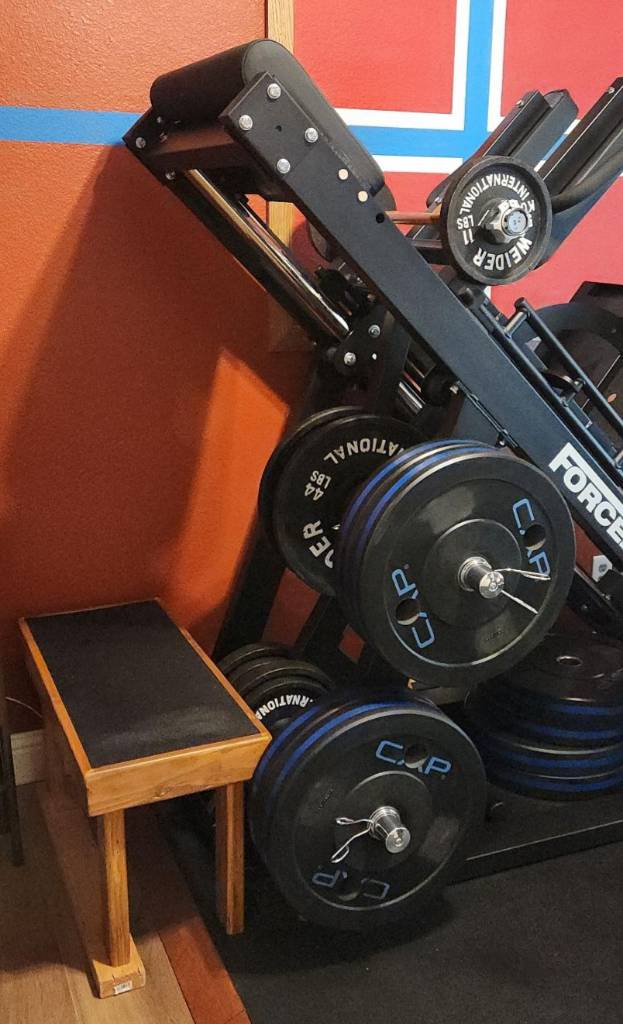 > > If I were to do this again, I'd figure out a way to reduce the amount of routing needed for the inner edge, since I essentially removed 0.75 inch by 1.5 inch of material all around the edge. This took forever, and perhaps a CNC machine would have simplified things, in addition to squaring and planing the surfaces before mitering. > >

cross-posted from: https://sh.itjust.works/post/22165919 > This entry of mine will not match the customary craftsmanship found in this community, but seeing as this was formerly a pile of miscellaneous, warped scrap 2x4 segments recovered from old pallets, I think I've made a reasonable show of things. > > This bench is for my homegym, designed to be stood upon, which is why there's a rubber mat inlaid on the surface, a leftover of the gym floor. My design criteria called for even the edge of the top surface to support weight, so the main "box" of the bench uses 2x4 segments mitered (badly) together at 45 degrees, held together with wood glue. > > I then routed the inner edge to support a 1/2" plywood sheet, which is screwed into the box. And then the rubber mat is glued down to the sheet, so there are no visible screws. > > Finally, the legs are also 2x4 segments, cut so the bench sits 43 cm (~17 inch) from the floor; this is only coincidentally similar to the IPF weightlifting bench standards. I used screws instead of glue, just in case the legs needed to be shortened later. > > All edges were rounded over with a 1/2" bit, as the bench is expected to be picked up and moved frequently. And everything stained in cherry and clear-coated. > > Some of the annoyances from using scrap included: > * Stripping old paint off. Awful chemicals, awful scrubbing, awful disposal. > * Sanding away twists along the 2x4 segments > * Filling nail holes or arranging them so they don't draw attention > * My lack of experience with clamping and gluing wood that's not dimensionally consistent > > 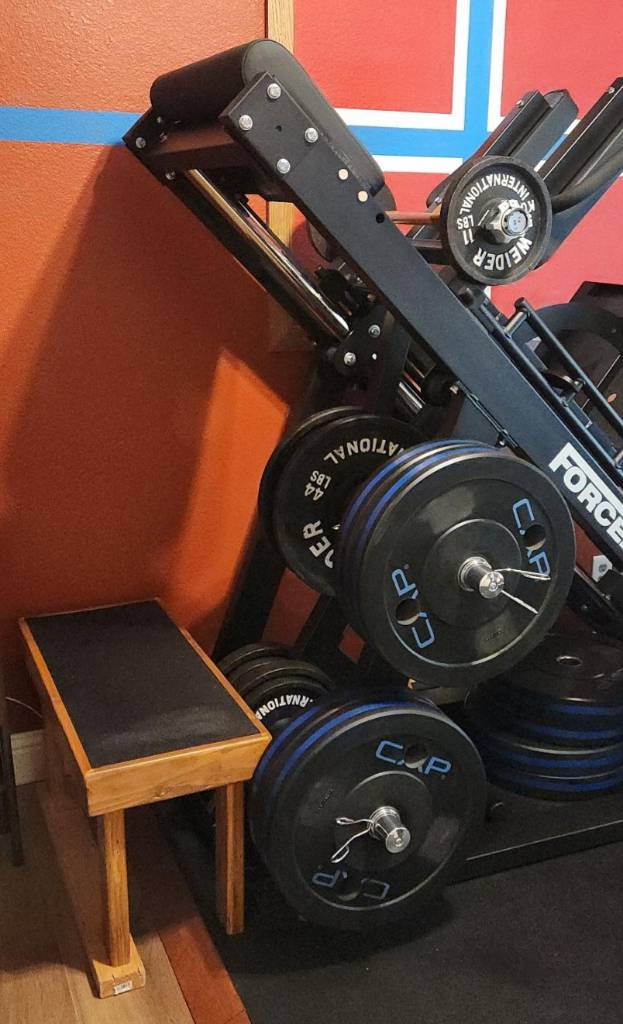 > > If I were to do this again, I'd figure out a way to reduce the amount of routing needed for the inner edge, since I essentially removed 0.75 inch by 1.5 inch of material all around the edge. This took forever, and perhaps a CNC machine would have simplified things, in addition to squaring and planing the surfaces before mitering. > >

This entry of mine will not match the customary craftsmanship found in this community, but seeing as this was formerly a pile of miscellaneous, warped scrap 2x4 segments recovered from old pallets, I think I've made a reasonable show of things. This bench is for my homegym, designed to be stood upon, which is why there's a rubber mat inlaid on the surface, a leftover of the gym floor. My design criteria called for even the edge of the top surface to support weight, so the main "box" of the bench uses 2x4 segments mitered (badly) together at 45 degrees, held together with wood glue. I then routed the inner edge to support a 1/2" plywood sheet, which is screwed into the box. And then the rubber mat is glued down to the sheet, so there are no visible screws. Finally, the legs are also 2x4 segments, cut so the bench sits 43 cm (~17 inch) from the floor; this is only coincidentally similar to the IPF weightlifting bench standards. I used screws instead of glue, just in case the legs needed to be shortened later. All edges were rounded over with a 1/2" bit, as the bench is expected to be picked up and moved frequently. And everything stained in cherry and clear-coated. Some of the annoyances from using scrap included: * Stripping old paint off. Awful chemicals, awful scrubbing, awful disposal. * Sanding away twists along the 2x4 segments * Filling nail holes or arranging them so they don't draw attention * My lack of experience with clamping and gluing wood that's not dimensionally consistent  If I were to do this again, I'd figure out a way to reduce the amount of routing needed for the inner edge, since I essentially removed 0.75 inch by 1.5 inch of material all around the edge. This took forever, and perhaps a CNC machine would have simplified things, in addition to squaring and planing the surfaces before mitering.
When uploading photos using the desktop website, make sure to select Full Resolution in the Upload Preferences.

The idea for this strange combination of arm day and leg day came from realizing that [my existing leg press](https://sh.itjust.works/post/20320680) and many commercial preacher curl benches both share a 45 degree angle. So in the interest of consolidating floor space, I decided to build a preacher curl bench attachment for my [Force USA machine](https://www.forceusa.com/products/ultimate-leg-press-hack-squat-combo). Just like with stripping down the machine to fit against a wall, the goal is to build something which is removable, if I wanted to restore the machine back to factory condition. Conveniently, at the top end of the machine, there are three 11/16 inch (17 mm) holes on each side, meant for resistance band pegs. Likewise, between the frame and the chrome running surface is approximately 1.5" (38 mm). Thus, it made the most sense to cut pieces of 2x4 lumber (actual size: 1.5x3.5 inch) that will sit within the frame, secured by two snug-fitting 5/8 inch (16 mm) wood dowels going through the top-most band peg holes. These side-pieces are held captive by the dowels, although the pieces can still slide inward of the frame, falling away from the peg holes. They're also not really weight-bearing. But they do provide a foundation to build upon. To form a sturdy and flat base, I then cut some scrap 3/4 inch (19 mm) board that spans the width of the frame, and screwed it down onto the side-pieces using Torx deck screws, notched to avoid protrusions on the frame's top surface. This makes the board weight-bearing, since it rests flat upon the frame; the side-pieces prevent the board from sliding down. And by fixing the width of the side-pieces, the pieces can no longer fall away from the peg holes. 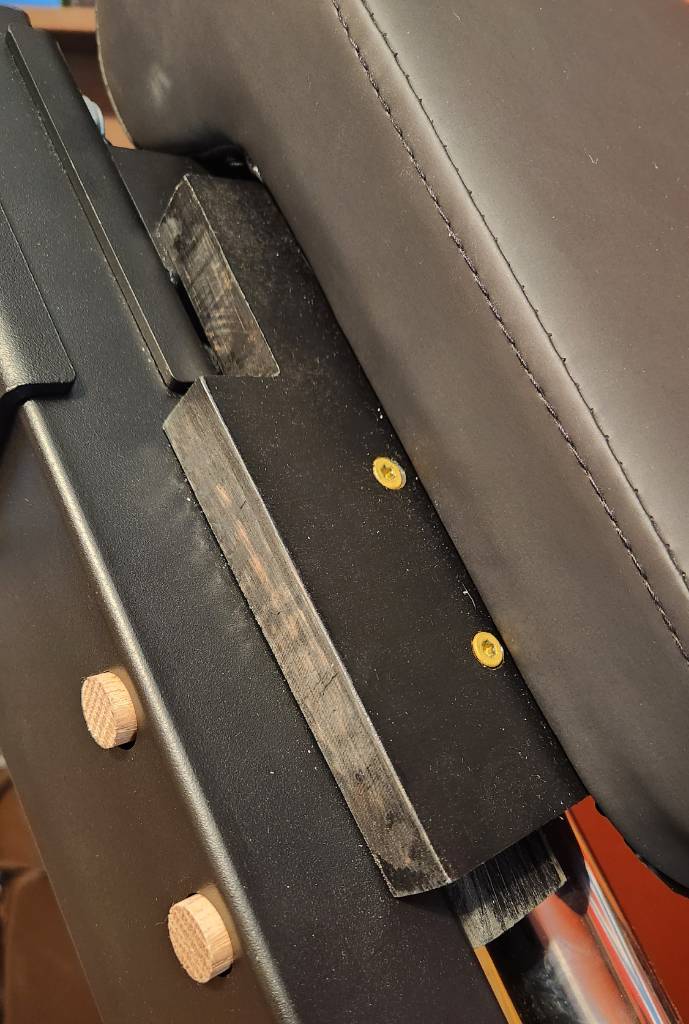 Finally, any preacher curl bench requires a pad. For this, I simply went online and found what existing machines used. Having had a good experience with the parts department at Body Solid [for my functional trainer](https://sh.itjust.works/post/16087080), I looked at their [GPCA1 preacher curl station](https://www.bodysolid.com/home/gpca1/preacher_curl_station), whose [detailed PDF schematics](https://www.bodysolid.com/Images/Products/GPCA1/Schematics/GPCA1.pdf) showed a pad that is 600 mm wide, which is perfect for my use! After $40 + $20 shipping, the pad arrived and I was able to measure the exact distance between its two bottom mounting holes to drill through the board. Once again, [Body Solid's documentation](https://adeasel-bodysolid-com.s3.amazonaws.com/dowloads/files/Manual_GPCA1.pdf) described the exact 5/16" wide, 1" long bolts that I would need to mount the pad. The final result isn't my nicest wood project -- to the point that I just stained it (badly) in black -- but it may have been one of the cheapest so far, using nearly entirely scrap materials except for the pad itself and the bolts. It also wasn't terribly complex and didn't require fairly high precision, [unlike the short barbell project](https://sh.itjust.works/post/20965205). The whole premise of this attachment is that as an average height American (5 ft 9 inch; 175 cm), my range of motion for the leg press and hack squat simply won't ever push the carriage into the upper part of the frame. So it's free real estate. 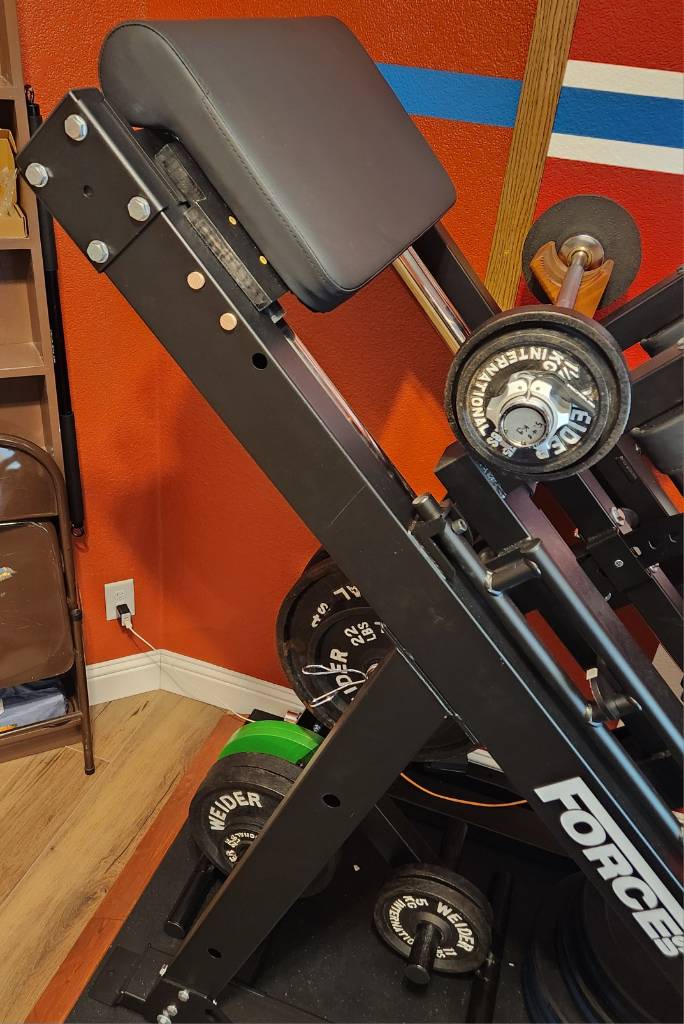 But wait: how am I going to use this? The pad is 5.5 ft (167 cm) above the floor. I'd have to be over 7 ft tall (2.2 m) to drape my arms over it. The answer to that will be its own future post.
This is different than the [promo from two days ago](https://sh.itjust.works/post/20950773). When uploading photos using the desktop website, make sure to select Full Resolution in the Upload Preferences.

cross-posted from: https://sh.itjust.works/post/20965205 > This is the story of how I turned a [15" Titan adjustable dumbbell](https://titan.fitness/products/loadable-15-in-olympic-dumbbell-handle-pair) to be 80 cm (31.5 inch) long. Why? Because I have [a space-constrained home gym but still wanted a leg press](https://sh.itjust.works/post/20320680), and so I had to remove its original barbell. > > In its place, I built a pair of wood mounts for a normal barbell to rest upon, covered in that earlier post. However, since this machine is wall-adjacent, such a barbell would have to fit inside the width of the leg press, so about 80 cm. But must also be wider than the spacing from outside-edge to outside-edge of the wood mounts, which is 60 cm. > >  > > Such a short barbell -- or long dumbbell -- does not readily exist commercially, with the narrowest one I've seen being 48 inch barbells, which are still too wide. So I decided to build my own, using my spare Titan dumbbell as the base. > > To start, the Titan dumbbells are excellent in this capacity, as the shaft diameter is 28 mm -- [not 32 mm as the website would indicate](https://titan.fitness/cdn/shop/files/430364_02.jpg) -- which is a common diameter, if I am to cut short a cheap barbell to replace this dumbbell's shaft. > > In keeping with my [preexisting frugality](https://sh.itjust.works/post/20133956), I purchased [a cheap 1-inch barbell](https://www.amazon.com/dp/B09FFQR9C8), hoping that it adopts the Olympic 28 mm shaft diameter, and not the 29 mm deadlift bar shaft diameter, as the Titan collars have small clearances. Matching neither, I find that this bar is closer to 23 mm, which although will fit into the existing collars, poses its own issues. > > Nevertheless, this 7 ft barbell can conveniently be cut in half to yield two 42 inch segments. And then the included bar stops can be loped off, and then the length further refined to 77 cm, thus hiding the marks from the bar stop within the Titan collars, and also centering the (meh) knurling from the cheap bar. > > But perhaps a picture will be more explanatory. Here, the original collar is dismantled at the top, showing the original shaft with a groove cut into it, about 1/4-inch from the end. Into that groove would fit two half-rings with an inner diameter of 20.4 mm and an outer diameter of 40 mm. In fact, all the parts inside the collar use 40 mm outer diameter, except the spacer cylinder, which is smaller at 37 mm. All of these parts are held captive within the collar using the C-ring and the geometry of the collar itself. > >  > > To deal with the difference between the collar expecting 28 mm, and the cheap bar's 23 cm, I designed an ABS 3d printed part in [FreeCAD](https://www.freecad.org/) to act as a bushing, upon which the original Titan brass bushing will ride upon. This ABS bushing is held captive by way of its center bulge, which fits within the dead space inside the collar. > >  > > As for how I cut the groove into the end of the new shaft, I still don't own a lathe. So the next best is to mount an angle grinder onto a "cross slide vise" taken from a drill press, with the shaft secured in a wooden jig to only allow axial rotation manually. The vise allows precision control for the cutting wheel's depth, with me pausing frequently to measure how close the groove is to the desired 20.4 mm inner diameter. This is.... not a quick nor precise process. But it definitely works. > > 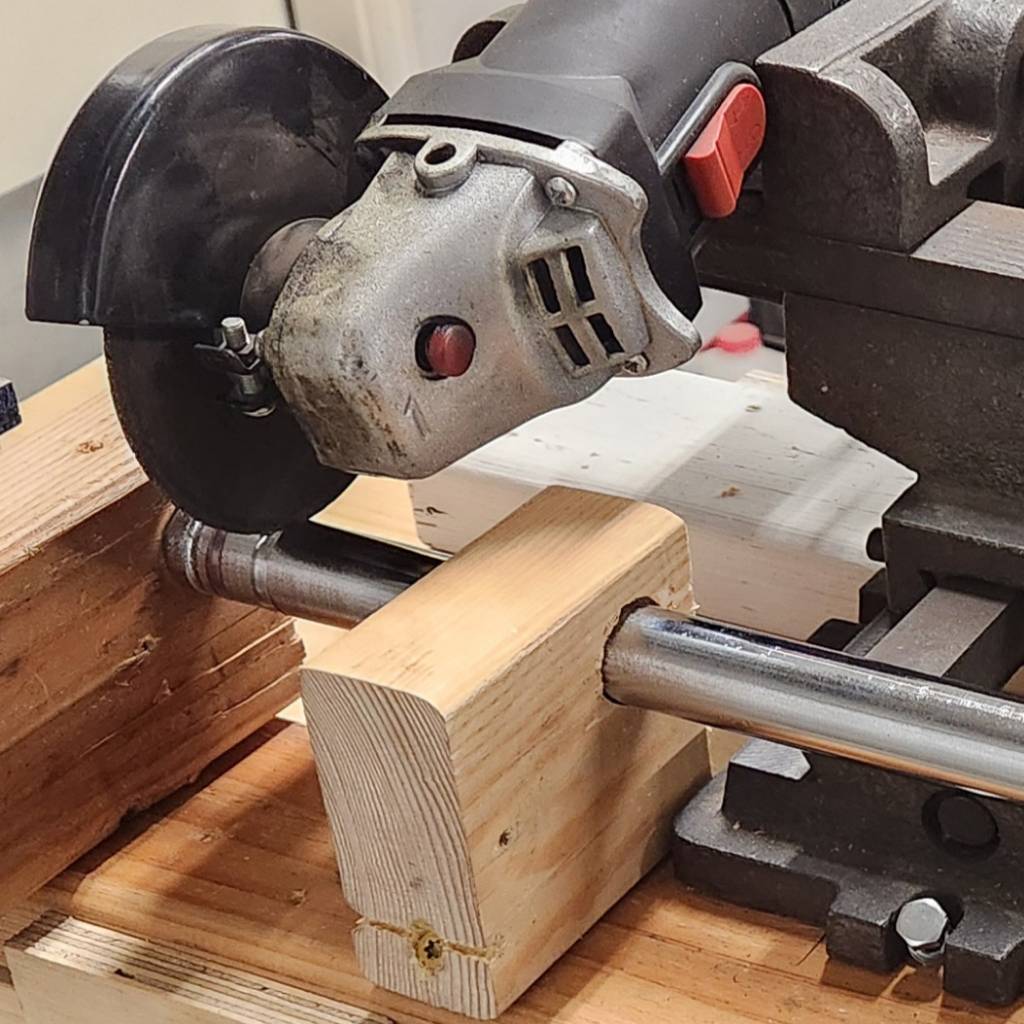 > > After reassembling both collars onto the new shaft and lubricating with white lithium, the final result is a long dumbbell (or short barbell) with Titan's 3.5 inch collars on the end, with 63 cm of shaft exposed and 80 cm from end to end. The ABS bushing is remarkably smooth against the brass bushing, after some sanding with 180 grit. The whole dumbbell weights 5.48 kg empty. > >  > > Here is the comparison with the stock Titan dumbbell. It's pretty amazing how the knurling conveniently lined up. It fits well onto the wood mounts of the leg press. > >  >  > > But why would I do all this just to add a weirdly long 3.5-inch collar dumbbell to a leg press, when it already can accept weights underneath the carriage? I will answer that in [a follow-up post](https://sh.itjust.works/post/21422161).

This is the story of how I turned a [15" Titan adjustable dumbbell](https://titan.fitness/products/loadable-15-in-olympic-dumbbell-handle-pair) to be 80 cm (31.5 inch) long. Why? Because I have [a space-constrained home gym but still wanted a leg press](https://sh.itjust.works/post/20320680), and so I had to remove its original barbell. In its place, I built a pair of wood mounts for a normal barbell to rest upon, covered in that earlier post. However, since this machine is wall-adjacent, such a barbell would have to fit inside the width of the leg press, so about 80 cm. But must also be wider than the spacing from outside-edge to outside-edge of the wood mounts, which is 60 cm. 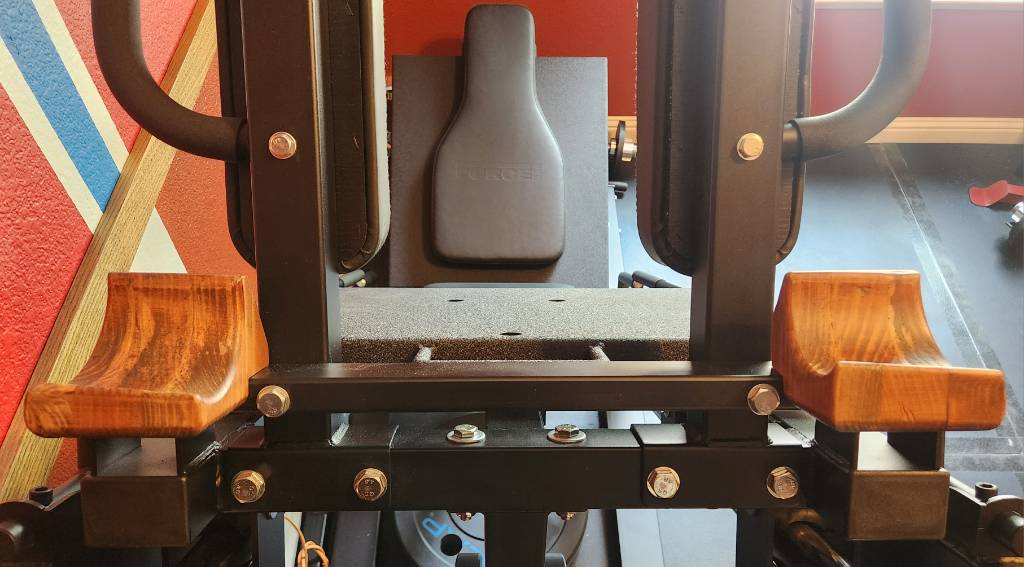 Such a short barbell -- or long dumbbell -- does not readily exist commercially, with the narrowest one I've seen being 48 inch barbells, which are still too wide. So I decided to build my own, using my spare Titan dumbbell as the base. To start, the Titan dumbbells are excellent in this capacity, as the shaft diameter is 28 mm -- [not 32 mm as the website would indicate](https://titan.fitness/cdn/shop/files/430364_02.jpg) -- which is a common diameter, if I am to cut short a cheap barbell to replace this dumbbell's shaft. In keeping with my [preexisting frugality](https://sh.itjust.works/post/20133956), I purchased [a cheap 1-inch barbell](https://www.amazon.com/dp/B09FFQR9C8), hoping that it adopts the Olympic 28 mm shaft diameter, and not the 29 mm deadlift bar shaft diameter, as the Titan collars have small clearances. Matching neither, I find that this bar is closer to 23 mm, which although will fit into the existing collars, poses its own issues. Nevertheless, this 7 ft barbell can conveniently be cut in half to yield two 42 inch segments. And then the included bar stops can be loped off, and then the length further refined to 77 cm, thus hiding the marks from the bar stop within the Titan collars, and also centering the (meh) knurling from the cheap bar. But perhaps a picture will be more explanatory. Here, the original collar is dismantled at the top, showing the original shaft with a groove cut into it, about 1/4-inch from the end. Into that groove would fit two half-rings with an inner diameter of 20.4 mm and an outer diameter of 40 mm. In fact, all the parts inside the collar use 40 mm outer diameter, except the spacer cylinder, which is smaller at 37 mm. All of these parts are held captive within the collar using the C-ring and the geometry of the collar itself. 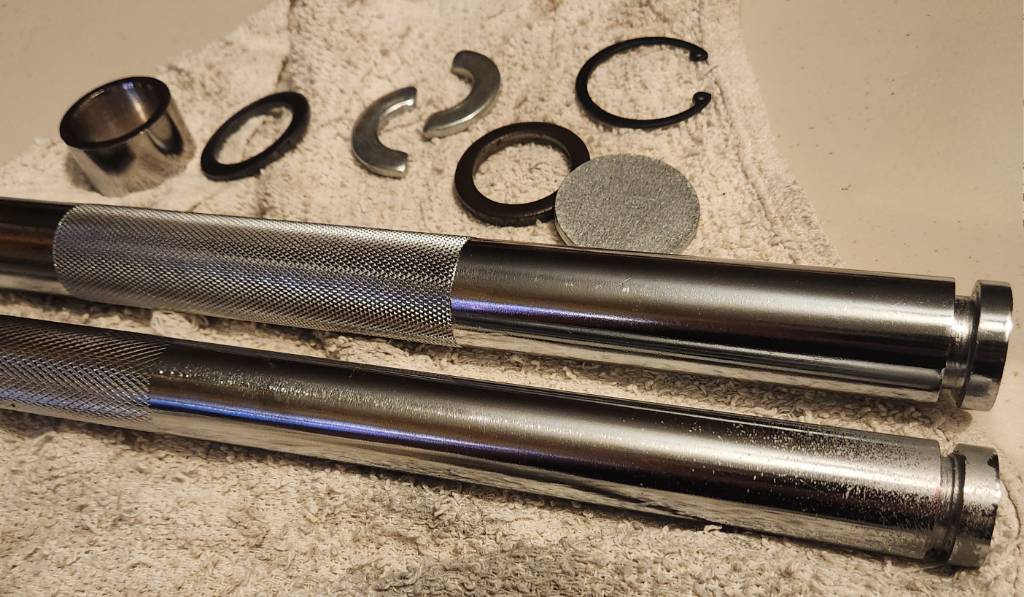 To deal with the difference between the collar expecting 28 mm, and the cheap bar's 23 cm, I designed an ABS 3d printed part in [FreeCAD](https://www.freecad.org/) to act as a bushing, upon which the original Titan brass bushing will ride upon. This ABS bushing is held captive by way of its center bulge, which fits within the dead space inside the collar. 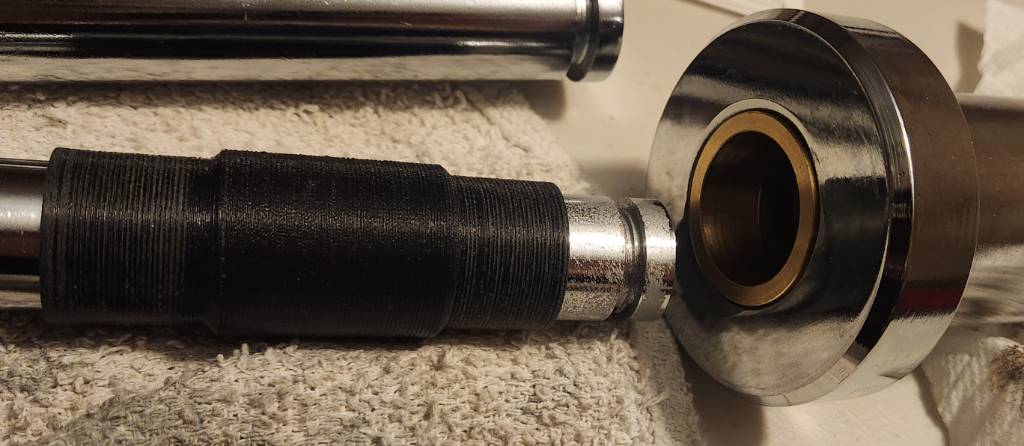 As for how I cut the groove into the end of the new shaft, I still don't own a lathe. So the next best is to mount an angle grinder onto a "cross slide vise" taken from a drill press, with the shaft secured in a wooden jig to only allow axial rotation manually. The vise allows precision control for the cutting wheel's depth, with me pausing frequently to measure how close the groove is to the desired 20.4 mm inner diameter. This is.... not a quick nor precise process. But it definitely works. 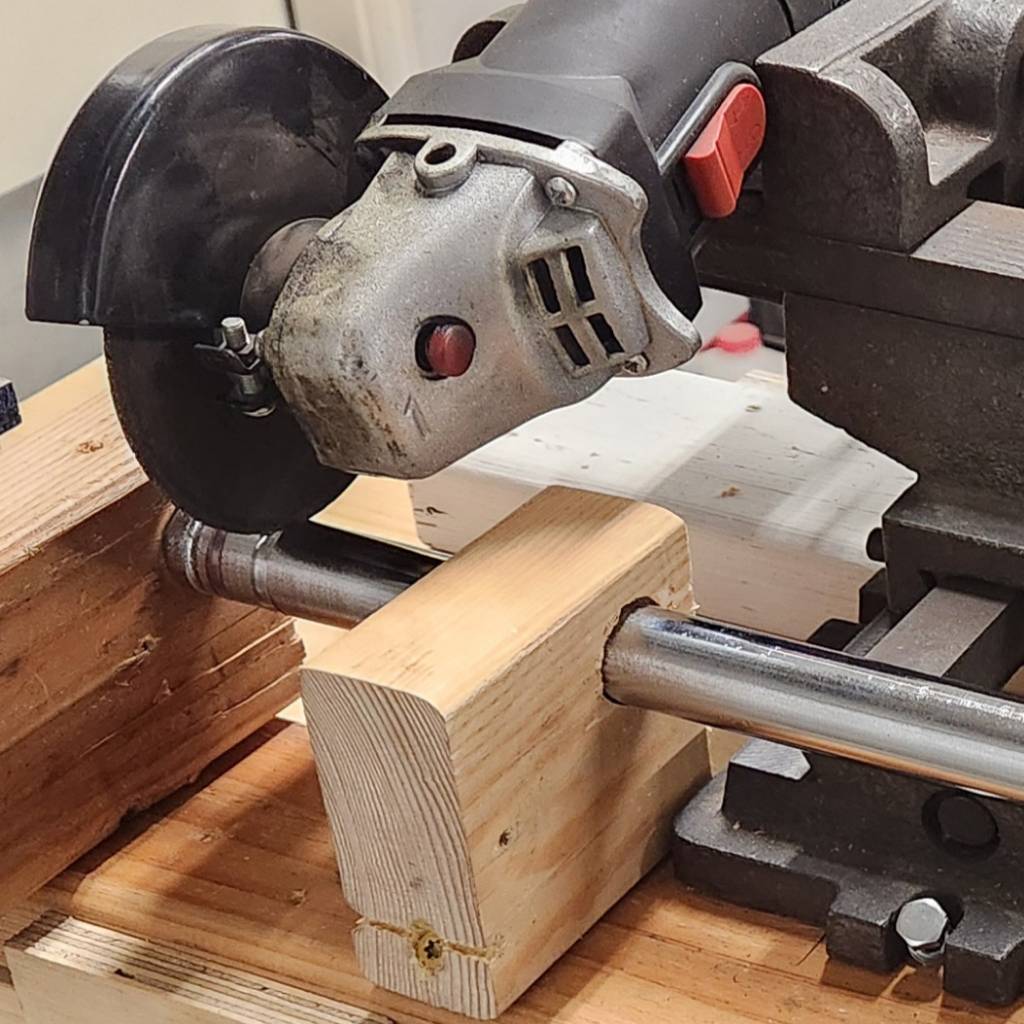 After reassembling both collars onto the new shaft and lubricating with white lithium, the final result is a long dumbbell (or short barbell) with Titan's 3.5 inch collars on the end, with 63 cm of shaft exposed and 80 cm from end to end. The ABS bushing is remarkably smooth against the brass bushing, after some sanding with 180 grit. The whole dumbbell weights 5.48 kg empty. 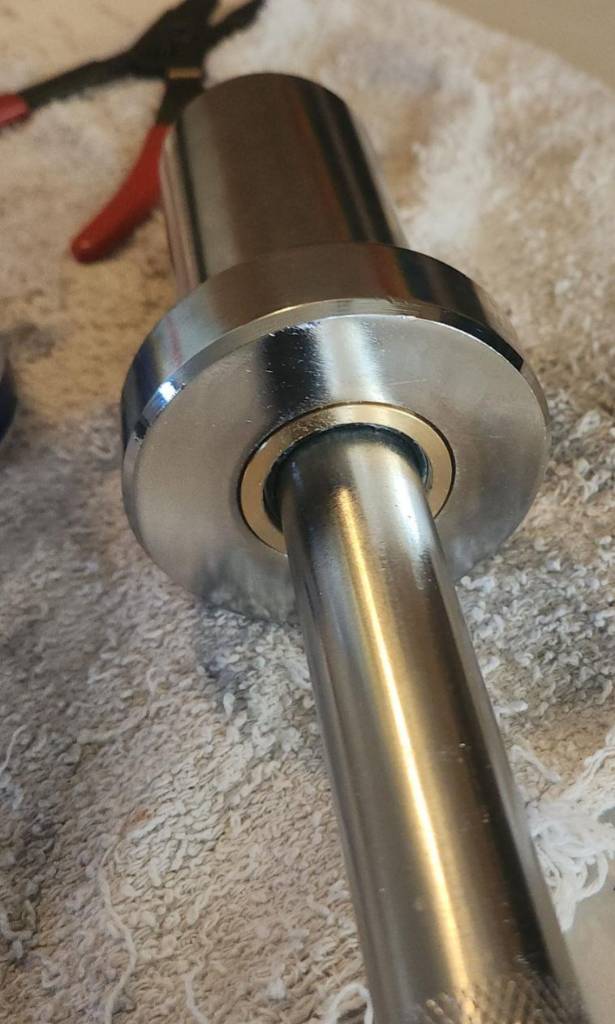 Here is the comparison with the stock Titan dumbbell. It's pretty amazing how the knurling conveniently lined up. It fits well onto the wood mounts of the leg press.   But why would I do all this just to add a weirdly long 3.5-inch collar dumbbell to a leg press, when it already can accept weights underneath the carriage? I will answer that in [a follow-up post](https://sh.itjust.works/post/21422161).
When uploading photos using the desktop website, make sure to select Full Resolution in the Upload Preferences.
 photo.walgreens.com
photo.walgreens.com
Use the code on the Walgreens app and the website to claim the same offer twice! When uploading photos using the desktop website, make sure to select Full Resolution in the Upload Preferences.
 youtu.be
youtu.be
As is their custom, FortNine delivers a two-wheeler review in the most cinematic way possible, along with a dose of British sitcom humor. I'm not sure I'd ever buy one, but I'd definitely borrow it from a friend haha. I've said before that I like seeing what novel ideas people will build atop two wheels, and this certainly is very unique.
The title describes the gist of things. In 18 months of owning my [Bikonit MD750](https://bikonit.com/collections/electric-mountain-bikes/products/bikonit-warthog-md750-ebike), I've traveled over 2100 km (1300 miles) in day, night, and rain; swapped out four sets of tires trying to lower the rolling resistance; [built my own new set of 29" wheels](https://sh.itjust.works/post/14630346) with [ebike-speed rated tires](https://www.schwalbetires.com/Marathon-E-Plus-11159055.01); and have taken it on mixed-mode adventures by using light-rail as my range extender. It's the latter where the weight is a small issue, as the light rail train has three stairsteps onboard, which I have to carry the bike up and onto. 43 kg is kinda a lot, although that does include all the things I will need for a day out. I can [pursue getting stronger](https://sh.itjust.works/post/16087080) to lift it more easily, or convincing the transit department to acquire low-floor trains, but I'd like to know my options: What are some Class 3, mid-drive ebikes currently available in the USA, that weigh less than 43 kg (95 lbs)? Ideally, less than 25 kg (55 lbs) too, as that's the most common weight restriction for buses. I want to see what y'all can recommend, irrespective of price or range or other considerations. I'm not likely to terminate my investment in this current ebike, as it's provided sterling service thus far. But I wonder if maybe what I have has already been outmoded by the latest developments in this ever-changing slice of the mobility space. TY in advance!

One thing I've always wanted for my space-constrained homegym is a leg press. But even the most compact leg presses occupy a lot of space lengthwise and width-wide. I had my eye on the [Force USA 45 degree leg press/hack squat combo machine](https://www.forceusa.com/products/ultimate-leg-press-hack-squat-combo), because it has so much capacity for me to grow into. So I picked one up and modified it so it can be placed up against the wall. The primary issue is the barbell that attaches to the carriage (the part that moves up and down). This barbell extends about 45 cm (18 inch) beyond the left and right sides of the machine, taking up stationary space as well as dynamic space when the carriage is in motion. Eliminating that barbell would reduce the width requirement from [the bare minimum of 162 cm](https://www.forceusa.com/cdn/shop/files/mlphs-dimensions-iso_a396ba7e-4e91-43e9-b371-b9d085328157.png?crop=center&height=570&v=1686002042&width=570) to 80 cm, assuming the weight storage pegs are also removed. But of course, the barbell is how the leg press is loaded, with 34 cm on each end for Olympic-spec plates. It also provides some structural stability for the hack squat shoulder pads, where they attach to the carriage. However, dangling underneath the carriage is a much-smaller space for loading plates, with 20 cm on left/right for plates. 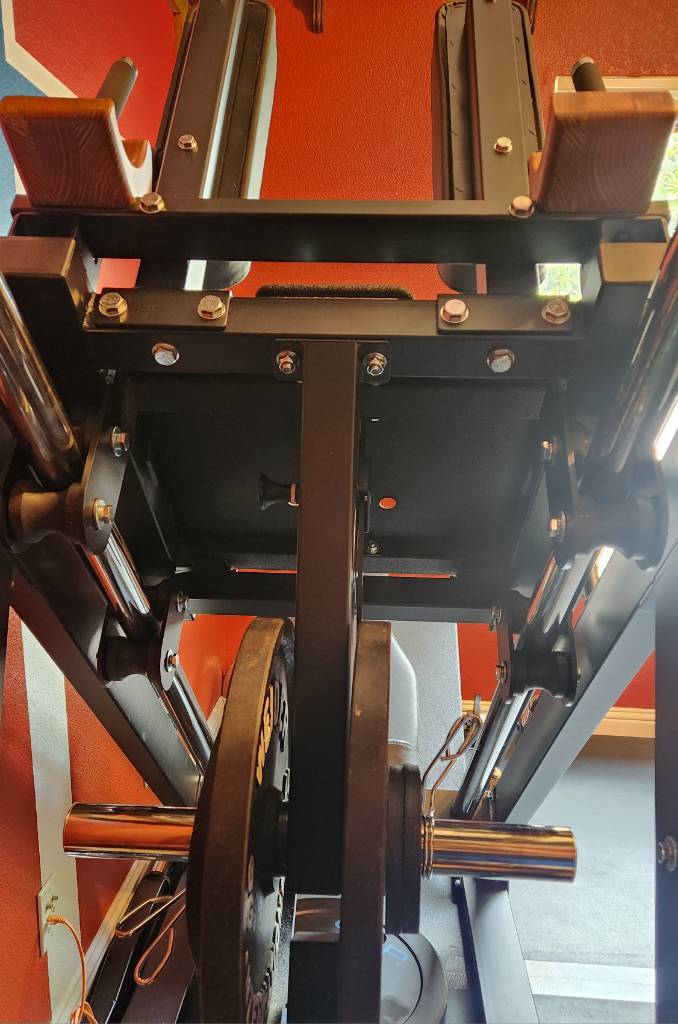 As an aside, this is a fairly substantial machine that arrived on a pallet, taking a few hours to assemble. The build quality is exemplary, and everything about it evinces durability and stability. My approach was to remove the original barbell, loading only the under-carriage bar. To retain structure, I cut [1"x2" rectangular steel tube](https://www.amazon.com/dp/B007WLWQDE) to the width of the carriage (59 cm), [capped](https://www.amazon.com/dp/B086HHF8FZ) the ends, and drilled holes to reuse the same bolts as the original barbell. The reason for 1"x2" is because the backrest for the hack squat requires clearance; the stock barbell solved this by bending around that area, whereas 1x2 _just barely_ clears the backrest, and that's good enough for me.  Later, I added a pair of wooden mounts where a conventional barbell can be rested. This is not my proudest woodworking achievement, but it's certainly the most unconventional. Each mount is made from three layers of reclaimed 2x6 lumber (from a bed frame) glued together, then a 3.5-inch diameter hole bored through axially, then sanded, stained in cherry, and finished with Polycrylic clear coat for durability. I'll explain the point of these mounts [in a different post](https://sh.itjust.works/post/20965792). 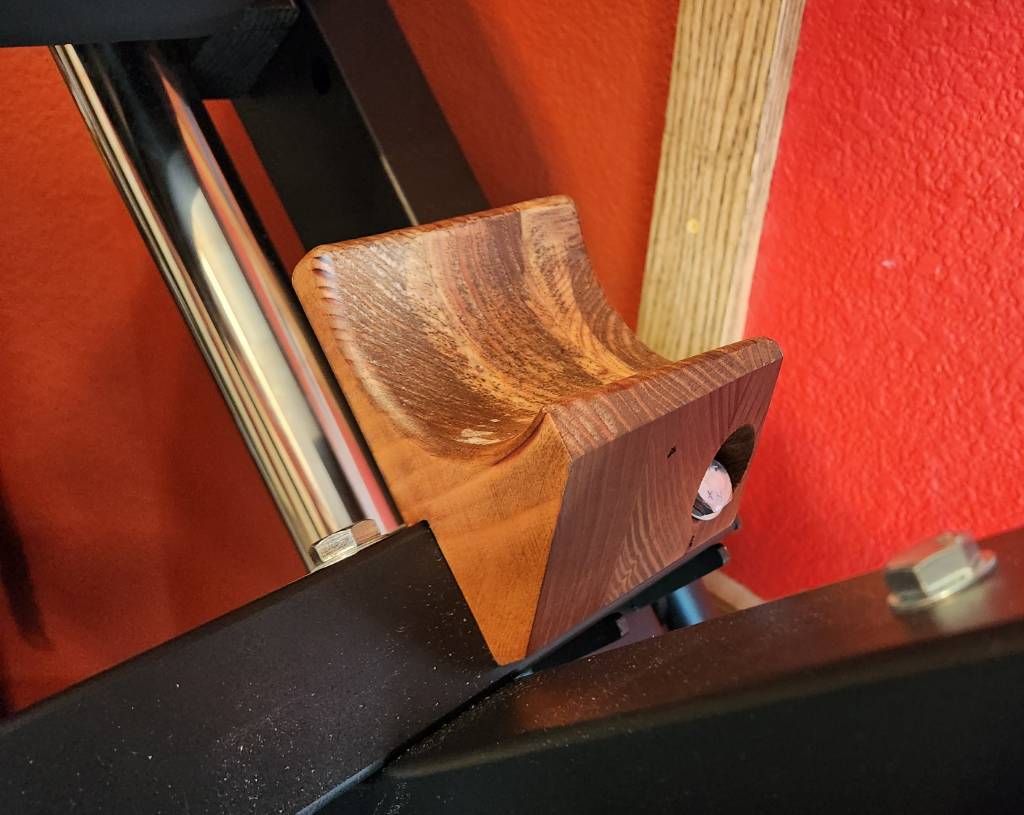 The result of all this is a leg press that needs only about 1 meter by 2.4 meter (39" by 96") of floor space, and that's including weight storage pegs on the side away from the wall, plus space to swing the safety stopper bars in/out of place. And everything can be reverted back to the factory configuration. The caveat is that I'm consigned to the 40 cm total barbell space under the carriage. To maximally load this machine, I would need to invest in thin iron plates, which apparently only are made to precise values, and are thus expensive. Examples: [Rogue calibrated KG plates](https://www.roguefitness.com/rogue-calibrated-kg-steel-plates), and [Hansu Power calibrated plates](https://www.ebay.com/itm/204103779363?var=504607354154), both of which are 22.5 mm wide for 20 kg plates. Sixteen such plates would make 320 kg (700 lbs), and I'd be thrilled if I could get there one day. The tradeoff is reasonable to me, minimizing floor space today in exchange for requiring expensive plates in the future, until I upsize my space.

cross-posted from: https://sh.itjust.works/post/20133956 > With the exception of the weight stack for [my functional trainer and its change plates](https://sh.itjust.works/post/16087080), I wanted all my subsequent equipment to be metric. To that end, I saw some cheap [45 lbs CAP bumper plates](https://www.amazon.com/gp/product/B0CLFQ5GG4?th=1&psc=1), and figured that I could make them into metric with not too much effort. > > Some rough math prior to purchasing suggested that these plates -- with a width of 68 mm -- could be slimmed down from 20.4 kg (45 lbs) to nearly 20.0 kg, by boring two 2" holes (51 mm). To keep balance, the holes should be on on diametrically opposite ends. And should be neither too close to the edge, nor too close to the center, since the plate still needs to absorb a drop without deforming. That the bored holes are 51 mm is a fantastic happenstance, nearly identical to the center hole for Olympic-spec plates. > > Examining each plate before drilling, I found that the silkscreen letter A in "CAP" is well-centered diametrically, although it doesn't line up with the matching logo on the back side. Also, since these are cheap CAP plates, the initial weight tolerances are pretty poor. 45 lbs should be 20.41 kg (2 [sig figs](https://en.wikipedia.org/wiki/Significant_figures)), but my first four plates registered at 20.58, 20.51, 20.64, 20.56. That's nearly an extra half pound! > > To drill the holes perfectly plumb, I did the work on a drill press using a [2-inch hole saw](https://www.homedepot.com/p/202327737). Because the saw wasn't deep enough to go through the full width in one pass, I started with a 1/4-inch (6 mm) pilot hole straight through the tip of the letter A in "CAP". Then I drilled from both sides with the hole saw until a ~200 gram rubber core fell out. Repeat for the second bore. > > To finish, I took some sandpaper to remove the old "45 lbs" markings, then used my [label maker](https://www.dymo.com/label-makers-printers/embossing-label-makers/dymo-organizer-express-pro-embossing-label-maker-kit-with-3-label-tapes/SAP_12966.html) to affix new values. All plates are still high, but ranged from 20.030 kg to 20.105 kg. Not too shabby, I think. > > In a happy coincidence, the position of these bored holes is perfect for one's thumbs when grasping the plate like a steering wheel, making it easier to pick up when laid flat on the floor. I also added a strip of [blue electrical tape](https://www.3m.com/3M/en_US/p/d/b00034627/) around the perimeter to make it easy to identify these as 20 kg. > > In the end, I got the cheap metric plates I wanted, and it came with a usability improvement as well. I've not dropped these yet, so time will tell how they hold up.

With the exception of the weight stack for [my functional trainer and its change plates](https://sh.itjust.works/post/16087080), I wanted all my subsequent equipment to be metric. To that end, I saw some cheap [45 lbs CAP bumper plates](https://www.amazon.com/gp/product/B0CLFQ5GG4?th=1&psc=1), and figured that I could make them into metric with not too much effort. Some rough math prior to purchasing suggested that these plates -- with a width of 68 mm -- could be slimmed down from 20.4 kg (45 lbs) to nearly 20.0 kg, by boring two 2" holes (51 mm). To keep balance, the holes should be on on diametrically opposite ends. And should be neither too close to the edge, nor too close to the center, since the plate still needs to absorb a drop without deforming. That the bored holes are 51 mm is a fantastic happenstance, nearly identical to the center hole for Olympic-spec plates. Examining each plate before drilling, I found that the silkscreen letter A in "CAP" is well-centered diametrically, although it doesn't line up with the matching logo on the back side. Also, since these are cheap CAP plates, the initial weight tolerances are pretty poor. 45 lbs should be 20.41 kg (2 [sig figs](https://en.wikipedia.org/wiki/Significant_figures)), but my first four plates registered at 20.58, 20.51, 20.64, 20.56. That's nearly an extra half pound! To drill the holes perfectly plumb, I did the work on a drill press using a [2-inch hole saw](https://www.homedepot.com/p/202327737). Because the saw wasn't deep enough to go through the full width in one pass, I started with a 1/4-inch (6 mm) pilot hole straight through the tip of the letter A in "CAP". Then I drilled from both sides with the hole saw until a ~200 gram rubber core fell out. Repeat for the second bore. To finish, I took some sandpaper to remove the old "45 lbs" markings, then used my [label maker](https://www.dymo.com/label-makers-printers/embossing-label-makers/dymo-organizer-express-pro-embossing-label-maker-kit-with-3-label-tapes/SAP_12966.html) to affix new values. All plates are still high, but ranged from 20.030 kg to 20.105 kg. Not too shabby, I think. In a happy coincidence, the position of these bored holes is perfect for one's thumbs when grasping the plate like a steering wheel, making it easier to pick up when laid flat on the floor. I also added a strip of [blue electrical tape](https://www.3m.com/3M/en_US/p/d/b00034627/) around the perimeter to make it easy to identify these as 20 kg. In the end, I got the cheap metric plates I wanted, and it came with a usability improvement as well. I've not dropped these yet, so time will tell how they hold up.
When uploading photos using the desktop website, make sure to select Full Resolution in the Upload Preferences.
 photo.walgreens.com
photo.walgreens.com
Use the code on the Walgreens app and the website to claim the same offer twice! When uploading photos using the desktop website, make sure to select Full Resolution in the Upload Preferences.
When uploading photos using the desktop website, make sure to select Full Resolution in the Upload Preferences.
 photo.walgreens.com
photo.walgreens.com
Use the code on the Walgreens app and the website to claim the same offer twice! When uploading photos using the desktop website, make sure to select Full Resolution in the Upload Preferences.
When uploading photos using the desktop website, make sure to select Full Resolution in the Upload Preferences.
Will Ramos and ABR was not on my 2024 bingo card. I'm not complaining. [Piped](https://piped.video/watch?v=S_rgW12ugNE) [Invidious](https://yewtu.be/watch?v=S_rgW12ugNE)
When uploading photos using the desktop website, make sure to select Full Resolution in the Upload Preferences.
The offer will apply only if there are two 5x7 prints in your cart. When uploading photos using the desktop website, make sure to select Full Resolution in the Upload Preferences.
 photo.walgreens.com
photo.walgreens.com
Use the code on the Walgreens app and the website to claim the same offer twice! When uploading photos using the desktop website, make sure to select Full Resolution in the Upload Preferences.
This September 2023 report by staff at the US Consumer Product Safety Commission compiles injury and fatality data involving micromobility devices, using data that was available at the time of publication. As the report notes multiple times, the aggregate data is fairly coarse and CPSC staff could only follow up on so many reports. Nevertheless, the report offers some rather interesting insights on e-scooters, hoverboards, and ebikes, although at 42 pages, some might prefer to just read the Executive Summary -- which is just 4 pages -- and skim the figures and tables. Some of my takeaways from the report: - ER visits for e-scooters have been at least double that of ebikes, although ebike data was below the reporting minimum so that data was estimated (page 10) - E-scooters and hoverboards ER visits by female/male are 35%/65% and 55%/45%, but ebikes are disproportionate at 24%/76% (page 12) - Two-thirds of hoverboard ER visits are for 5-14 year olds, the largest group of any age range for any micromobility device (page 13) - The vast, vast majority of ebike ER visits were incurred while riding on a public road or public property. No surprise there. (page 14) - July has the most ebike ER visits (14% of annual total), and January/February the least (3% each of annual total) (page 15) - The report has a whole section dedicated to e-scooters, starting at page 17 - One-third (32%) of treated e-scooter injuries indicated the rider was carrying or holding onto something, with 61% indicated not holding, and 7% unspecified (page 21) - 13% of treated e-scooter injuries indicated the rider was wearing a helmet, with 51% unspecified (page 22) - Between 2017 and 2022, using available data, CPSC found 104 deaths related to ebikes. These deaths skew heavily male (84 deaths) and 25+ years old (87 deaths) (page 23-24) - 58 of 104 ebike deaths involved collisions with motor vehicles, the leading cause. The data does not specify whether the ebike or motor vehicles or both were in motion at time of collision (page 25) - 8 of 104 ebike deaths involved pedestrian collisions, composed of six pedestrians and two ebike riders - 2 of 104 ebike deaths involved fire by the ebike batteries - 18 of 104 ebike deaths involved collisions with terrain, roadway features, or wayside obstacles (page 25) - Of 59 ebike injury reports that CPSC staff followed up, 28 identified fire hazards, the leading cause. 24 of 59 involved non-brake mechanical issues, such as bicycle components failing or detaching (page 28)
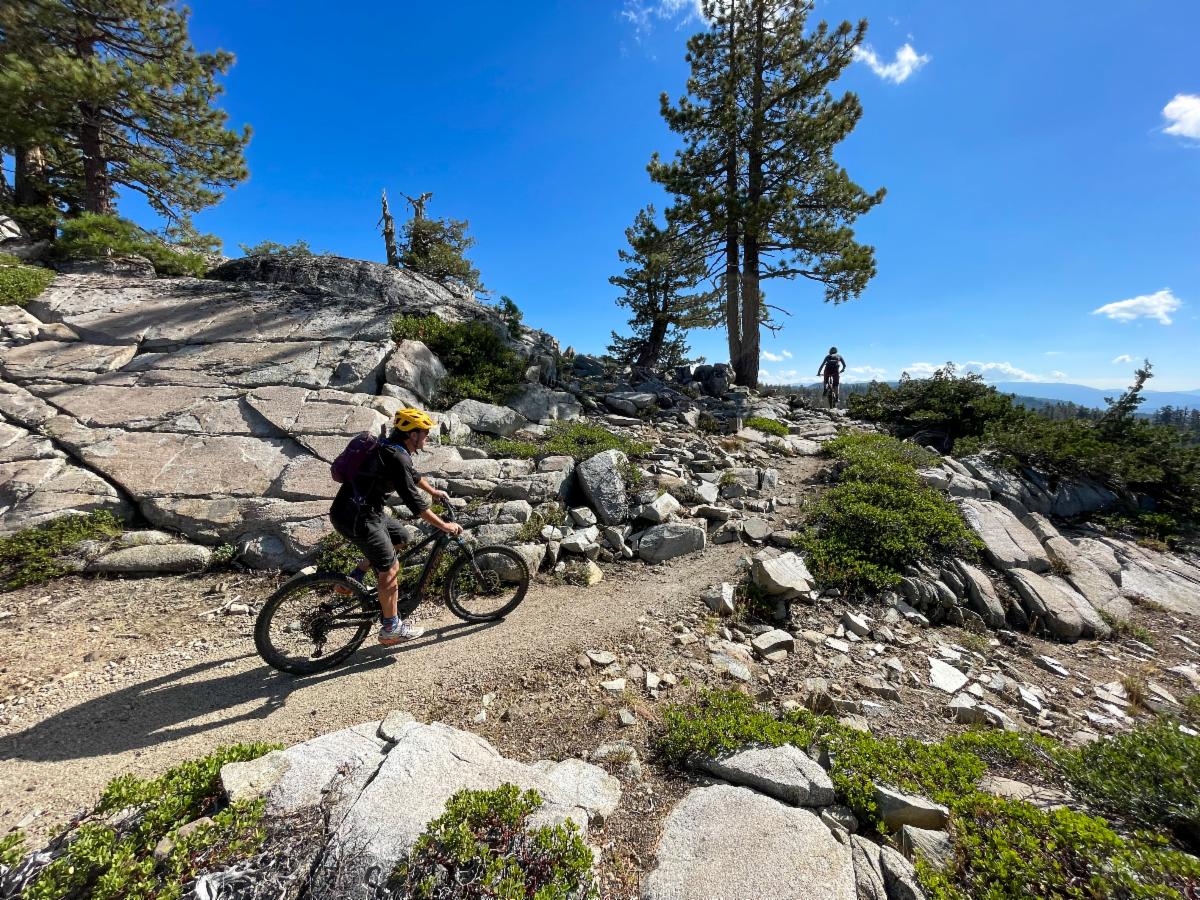 fox40.com
fox40.com
Additional coverage: https://www.sacbee.com/sports/outdoors/article286750940.html USDA press release: https://www.fs.usda.gov/detail/tahoe/news-events/?cid=FSEPRD1168193 A new trail in Tahoe National Forest in California would permit Class 1 ebikes, after the Forest Service ([part of the US Dept of Agriculture](https://www.fs.usda.gov/about-agency/meet-forest-service)) concluded that: > Class 1 e-bikes are equipped with a motor that provides assistance only when the rider is pedaling and ceases to provide assistance when the e-bike reaches the speed of 20 mph. Studies completed during project analysis indicated that Class 1 e-bikes are similar to traditional mountain bikes in terms of components, relative speeds and impacts to trails. > The inclusion of Class 1 e-bikes as an approved use on the trail expands access to individuals that may not be able to walk or ride a traditional bicycle as far or long. As the new trail sections to be constructed would create a 72 mile (115 km) route, ebikes will prove useful to those hoping to make the full trek as a day trip. Other trails parallel to or intersecting this new trail would remain subject to their existing rules regarding [ebikes](https://www.fs.usda.gov/detail/tahoe/recreation/?cid=FSEPRD719803), equestrians, and [automobiles and motorcycles](https://www.fs.usda.gov/detail/tahoe/maps-pubs/?cid=fseprd638275).
 photo.walgreens.com
photo.walgreens.com
Use the code on the Walgreens app and the website to claim the same offer twice! When uploading photos using the desktop website, make sure to select Full Resolution in the Upload Preferences.
When uploading photos using the desktop website, make sure to select Full Resolution in the Upload Preferences.
While writing [a comment on a different community](https://sh.itjust.works/comment/9748453), I figured I would post my homemade plate-bearing pegs here. These were made for my [Body Solid BFFT10R](https://www.bodysolid.com/home/bfft10r/best_fitness_functional_trainer) functional trainer's weight stack, to allow loading 50 mm Olympic fractional plates. This first one is a simple wooden peg made from a scrap 4x4 block, [turned on a router](https://www.youtube.com/watch?v=TUA3lryix64) -- because I don't own a lathe -- and with a threaded rod (3/8-inch; 10 mm) through it. The rod is mild steel, but that caused some minor bending when loaded with a 15 lbs plate. 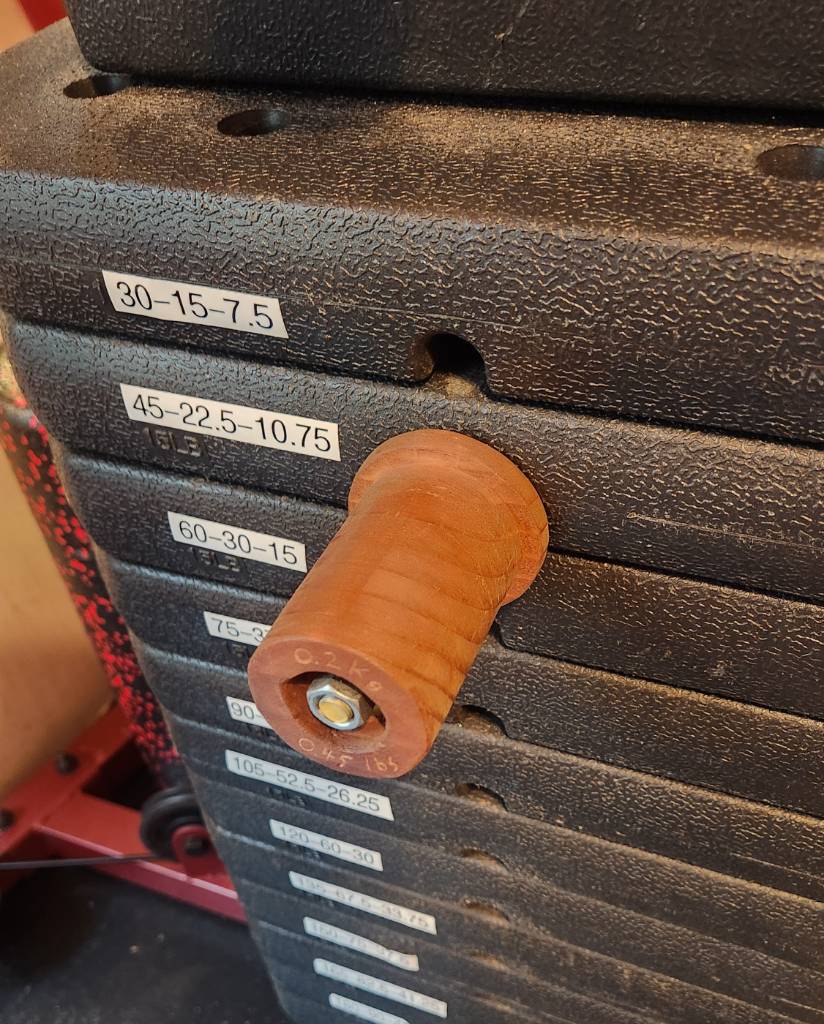 So for my second and more permanent attempt, I attached two back-to-back pegs directly to the weight stack's center point, using a [Grade B7 threaded rod](https://www.grainger.com/product/19NM90), in lieu of the original bolt that was there. This helps keep the weight stack balanced front-to-back, makes it run more smoothly, and there's a reduced risk of the plate slipping off. 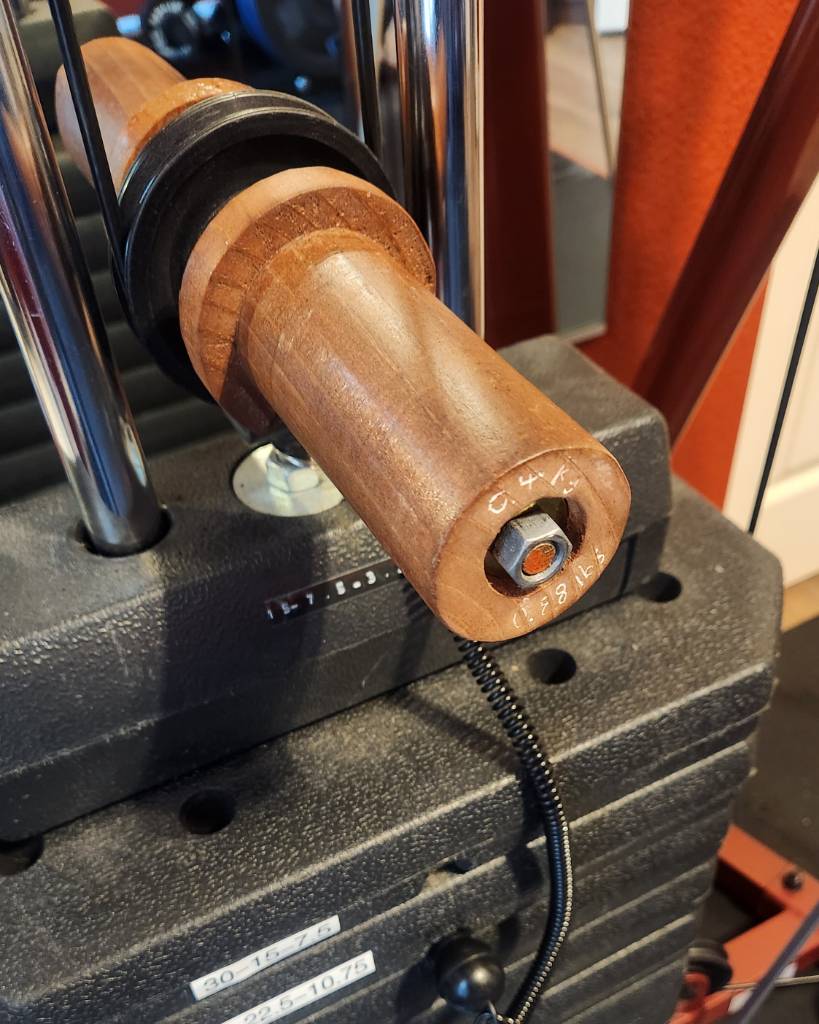
 photo.walgreens.com
photo.walgreens.com
This code does not appear to work on mobile, but does on desktop.
 photo.walgreens.com
photo.walgreens.com
Use the code on the Walgreens app and the website to claim the same offer twice! When uploading photos using the desktop website, make sure to select Full Resolution in the Upload Preferences.
(long time lurker, first time c/bikewrench poster) I have a [Bikonit MD750 ebike](https://bikonit.com/products/bikonit-warthog-md750-ebike) that currently wears its stock wheels with its third set of tires. The front is a 26" wheel (ETRTO 100-559) with 203mm brake rotors and 15x150mm thru-axle. The rear is also 26" (ETRTO 100-559) with 203mm brake rotors ans 12x197mm thru-axle. Both tires are 26x4.0, inflated to the max 30 PSI (~200 kPA), with a measured outside diameter of 74cm. On the rear is a 9-speed SRAM cassette and its matching HG-style splined freehub. **My problem**: I use this ebike as a fast (40-45 kph, 25-28 MPH) inter-city cruiser on paved roads, rather than off-road as the manufacturer might have intended. The long stretches of road shoulder I ride on have all manner of debris, and the wide tires are constantly hitting things. In 1400 km (~860 miles), I've had four rear-wheel flats (with two in the span of 12 hours!), presumably from both sharp objects and pinch flats due to hitting protrusions at speed. These tires are also a drag, since under human power only, I can barely hold 20 kph (13 mph) but on my acoustic bike with 700x32 tires, I'm closer to 28-32 kph (17-20 mph). At higher speeds under electric power, this drag can only get worse. The original tires were Kenda Juggernauts (too loud on pavement), and the second set were [Origin8 Supercells](https://www.bicyclebuys.com/origin8-supercell-26-x-4.0-folding-bead-tire/0600555) (too easily punctured above 32 kph (20 mph)). So I'd like to change to narrower tires, which also implies narrower rims. **Preliminary research**: Since the weight of this ebike is around 40 kg (88 lbs), I know I cannot run narrow tires -- like the aformentioned 700x32 -- since it might concentrate the wheel forces on too little of contact area. Also, I want to keep the tire widths manageable when taking public transport: the buses and trains here have a tire width limit of ~2.5 inch (64 mm), and I will retain the stock wheels for mounting any tires wider than this. [Two](https://www.lightbicycle.com/newsletter/tire-size-chart-for-bicycle-rim.html) different [references](https://bicycles.stackexchange.com/a/52590) suggest that 23mm rims might be my sweet spot, giving me a range of possible tire widths to later purchase, from about 1.5" to 2.4". For wheel diameter, I would prefer to retain or exceed the existing 74mm outside diameter, since it's not clear if I can easily reprogram this ebike's computer to acknowledge a different wheel circumference. A smaller outside diameter would cause the speed governor to engage prematurely, whereas a larger diameter is limited primarily by the frame around the rear wheel. By my measurements, this frame has clearance for an absolute maximum rear-wheel outside diameter of 82 cm. [This reference](https://bestwheelset.com/26-vs-27-5-vs-29-what-is-the-difference/) indicates that a 29" wheel has a rough outside diameter of 29" (73.6mm), give or take. One size smaller is the 27.5" wheel, with a slightly smaller outside diameter of 27.5" (69.8mm). Since my goal is to equate or exceed the existing 74cm outside diameter, I'm inclined toward a 29" wheelset. There may also be operational efficiencies, since a 29" wheel and my acoustic bike's 700C wheels [have identical ETRTO diameters of 622mm](https://www.sheldonbrown.com/tire-sizing.html#1). For example, I could possibly stock a single size of 700C spare tubes at home. Also, within mountain biking, there seems to be a trend of [seasonally switching between fatbike wheels and 29" or 29"+ wheels](https://www.mtbr.com/threads/summer-wheels-for-a-fat-bike-is-it-worth-it.1207065/), so I don't feel my desire is out-of-place. Finally, I wish to leave the 9-speed shifter alone, so that I can swap between this new wheelset and the stock wheelset at-will. This means the new rear wheel must also be compatible with 9-speed HG-style cassettes. [This compatibility chart](https://www.lightbicycle.com/newsletter/Bike-Freehub-Cassette-Compatibility-Manual.html) indicates that if the new hub is Shimano 8/9/10 or SRAM 9/10 speed compatible, then I'm set. And if the new hub is Shimano 11/12 or SRAM 11 speed compatible, then I can use [a 1.85mm spacer](https://www.amazon.com/dp/B00BO4X1SE) with my existing 9-speed HG cassette, which should be easy enough to find. **What I've found so far**: With a search criteria for a 29" wheelset with 150mm front and 197mm rear, with a 23mm inner rim and HG-style splines, I've found very few results that aren't custom builds. The [first (and least expensive) wheelset is from Bikesdirect.com](https://www.bikesdirect.com/products/parts/fatbike-29-tcs-wheels.htm) but it doesn't actually exist in stock, and its 29mm rim width is more than desired. The [next from Biktrix](https://www.biktrix.com/products/wheelset-27-5x3_150ta_197ta_solid-rim) is significantly wider, at 60mm rim width. The third and fourth are [from Ican](https://icancycling.com/products/carbon-29-fatbike-wheels-50mm-wide-hookless-tubeless-compatible-32-32h) and [Fyxation](https://www.fyxation.com/products/fyxation-blackhawk-x-duroc-40-29-wheelset?variant=8114015338604), at 50mm and 40mm respectively, and both wheelsets run into $700 territory. Of those four, two use Novatec D201SB-15/D202SB hubs, one uses Fyxation's own hub, and one is unspecified. All appear to support 15x150mm thru-axle in the front and 12x197mm thru-axle in the rear. Other search efforts showed that a bit more variety exists if I went with a 27.5" wheelset, but I'm trying to keep to the criteria from earlier. **Hub variety**: While researching 150/197mm hubs, it seems that various brands are relabeled, of varying quality. It seems [Framed and Novatec](https://www.mtbr.com/threads/framed-197mm-rear-hub.1123695/) are the same, [Pub is made by Bitex](https://www.mtbr.com/threads/moar-fun-with-the-house-cheap-hubs.1213420/), and DT Swiss is generally well-liked but expensive. I'm led to believe DT Swiss is on the higher end of the market, while Novatec and Pub are entry-level, with sporadic reports of [years of life](https://www.mtbr.com/threads/current-state-of-novatec-hubs.1056003/page-2?post_id=13501189&nested_view=1&sortby=oldest#post-13501189) or [months before failure](https://www.bikeforums.net/general-cycling-discussion/1158980-novatec-rear-hubs-complete-garbage.html). Certainly, on eBay, Pub and Framed sell for $40-60 while DT Swiss seems to be $300-400. **I need help**: First of all, thank you for reading this far. What I would like is to know whether I'm so far off the mark that I need to start over, or if this is a mostly solid criteria and it's just that no ready-made wheelsets for my use-case are available and that I should build or commission my own wheelset. To guide toward an answer, I wrote out some questions: 1. Are there alternatives I haven't considered for reducing punctures on an off-road style ebike currently wearing fatbike wheels? 2. Is a 29" wheelset right for my bike? 3. Is there some reason I shouldn't pair a 23mm rim width with 15x150mm/12x197mm hubs? 4. With no experience building or specifying wheelsets, should I first build a cheap custom wheelset as a beta version, then later commission a "good for lifetime", YOLO, high-quality wheelset as the final goal? Or should I cut straight to the chase? 5. Are there other -- ideally less than $1k -- wheelsets that I didn't find from my search efforts? 6. Is 12x197mm thru-axle really that rare? Is it rare because I'm looking for such a narrow rim? Or because I'm making a [grand tourer](https://en.wikipedia.org/wiki/Grand_tourer) out of an off-roader? 7. Is wheel-building difficult to do at home? [Sheldon Brown makes it sound straighforward](https://www.sheldonbrown.com/wheelbuild.html), although there was [a post here earlier](https://lemmy.world/post/11453985) about computing spoke lengths. 8. What 29" tires might be well-suited for speed, lower rolling resistance, reasonably high air pressure, and debris resistance on an ebike? Any and all advice would be greatly appreciated. Thank you!
 photo.walgreens.com
photo.walgreens.com
Use the code on the Walgreens app and the website to claim the same offer twice! When uploading photos using the desktop website, make sure to select Full Resolution in the Upload Preferences.
